Andasibe is a small village about 140km east of the capital city of Antananarivo, in Madagascar's eastern rainforest belt. The road from Tana is one of the better roads in the country. (It's still terrible, just not as terrible as most of the others.) After Anjozorobe, we stayed at a lodge in Andasibe for the next five nights. We also returned to this lodge for another two nights between Akanin'ny Nofy and Ranomafana. From this lodge we would sometimes walk to the closest forest, but more often our driver Joshua would take us to other nearby natural areas.
This is one of the most commonly visited regions of Madagascar for wildlife watchers, both because it is relatively easily accessible from Tana and because it has a good assortment of charismatic species, perhaps most especially the Indri, largest of the lemurs. I had been to this area on both of my previous visits to Madagascar. On both of those trips we had spent all of our time in Analamazaotra forest, which is the easiest spot to see Indri. On this trip we visited several reserves and natural areas, each of which had its own specialty species. Here I will mix together photos from all of the locations we visited near Andasibe.
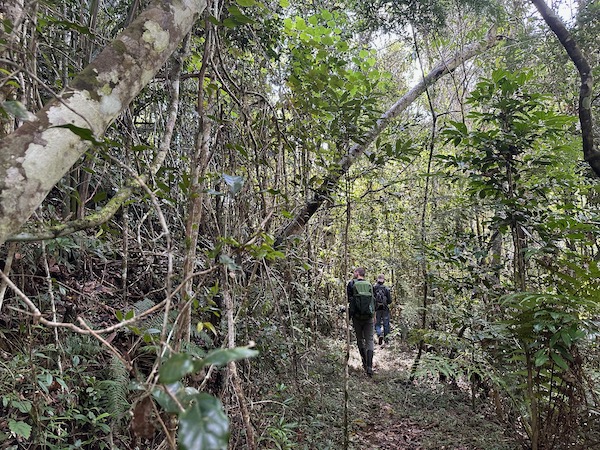
Ryan and José on a forest trail
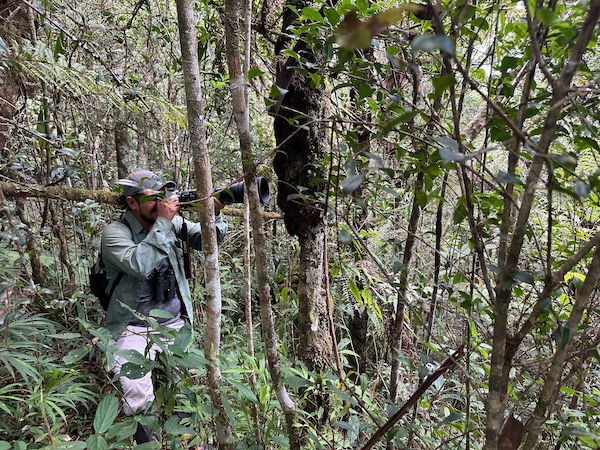
Frank aiming at the largest lemur
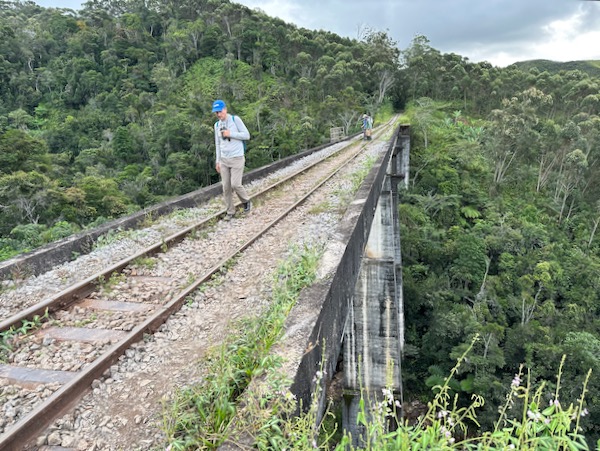
Mike on Madagascar's highest railway bridge
You'll have to bear with me through some invertebrates before we get to the frogs and chameleons and geckos that I know you're waiting for. (If you are here to see the invertebrates, ignore that comment.) I'll start with a handful of the best moths and butterflies.
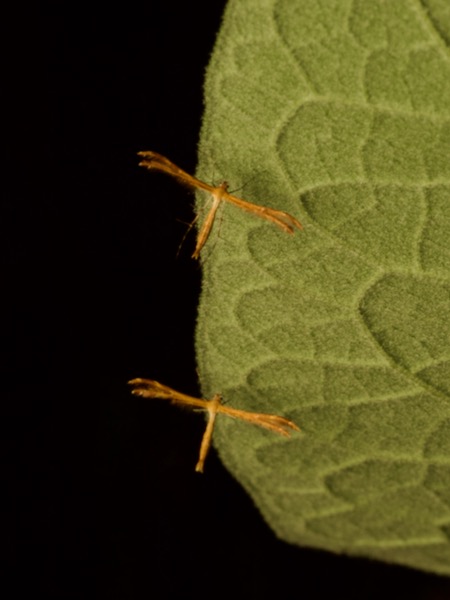
Unidentified plume moths, subfamily Pterophorinae
I am certain that these moths are engaged in some sort of synchronized dance maneuvers, but I don't know the details.
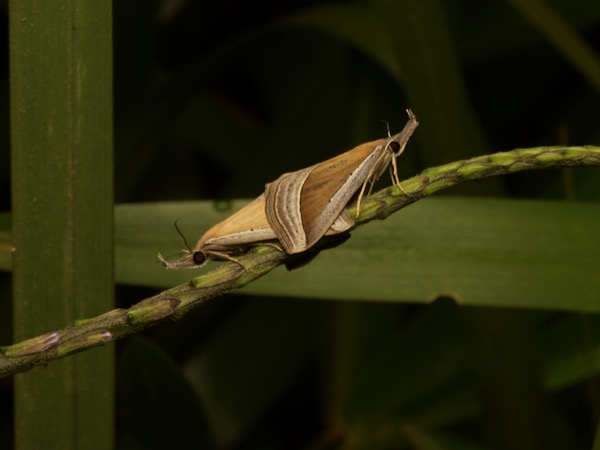
Hypena conscitalis
I could say the same thing here, but in this case I do know the details. These are among the Hypenine Snout Moths, which is not a group of moths that I had ever heard of. According to
Moths of Borneo, hypenine moths are the ones that have postspiracular (as opposed to prespiracular) counter-tympanal hoods. So now we know.
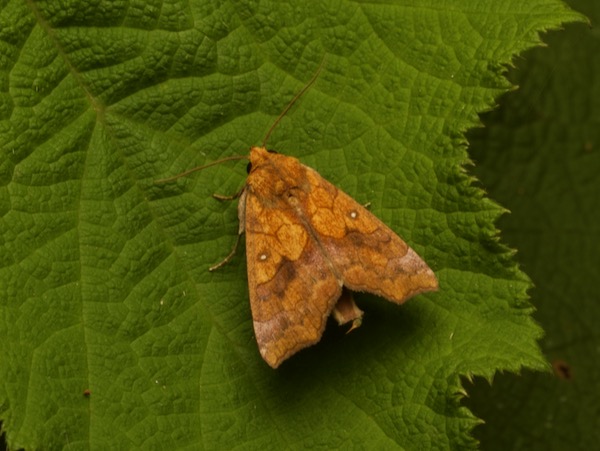
Tropical Anomis,
Anomis flava
This species is found around the world, as far south as Canberra, Australia, and as far north as Japan. Other Anomis species range up into Canada.
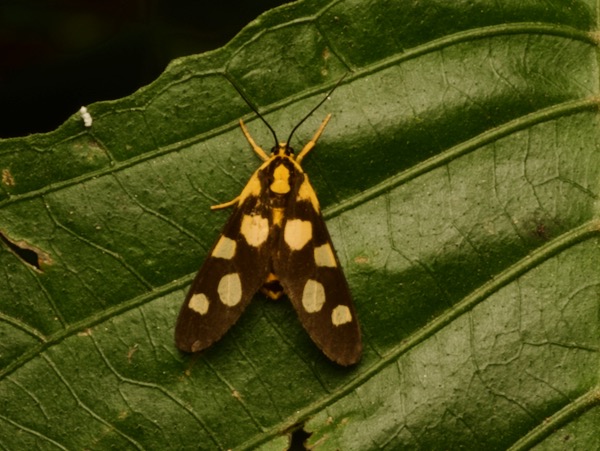
Thyrosticta minuta
These little beauties, and all the other Thyrosticta species, are known only from Madagascar.
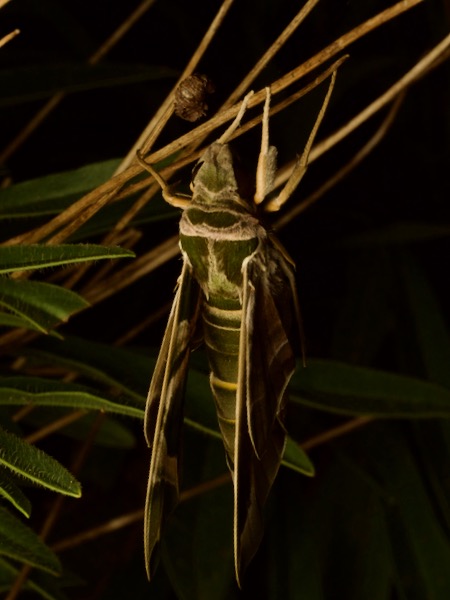
Oleander Hawkmoth,
Daphnis nerii
I'm a fan of all the sphinx moths, a.k.a. hawkmoths. This species is particularly beautiful, though its striking pattern is only hinted at here.
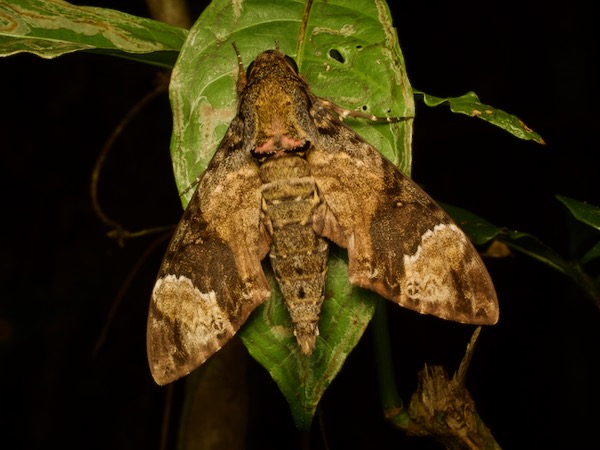
Fulvous Hawk,
Coelonia fulvinotata
This one isn't as lovely as the Oleander Hawkmoth, but at least it has posed in a way that more fully shows off its appearance.
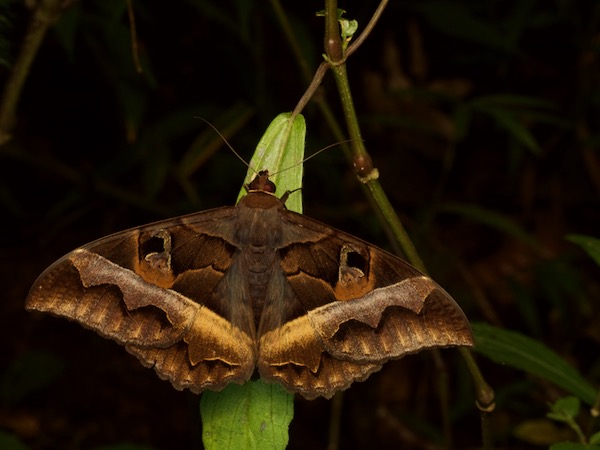
Cyligramma disturbans
This is the same common, large, and beautiful moth we saw at Anjozorobe. I never tired of seeing them posing on the vegetation at night. I did occasionally tire of them flapping around in my face though.
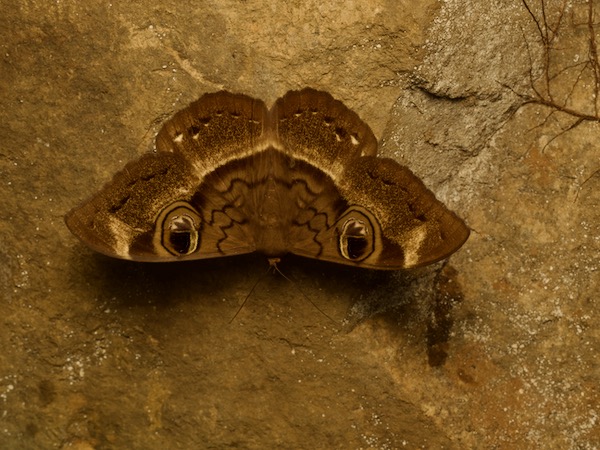
Cyligramma fluctuosa
We saw five or six of this closely related species on the inside walls of an old railroad tunnel.
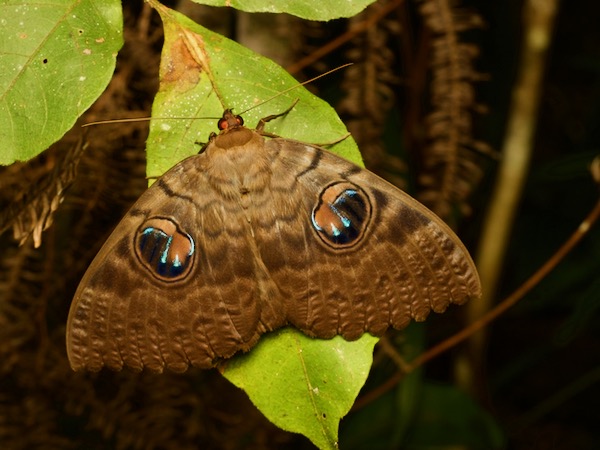
Walker's Owl,
Erebus walkeri
At night we saw quite a few of these similarly large and similarly fake-eye-spotted moths perched on leaves.
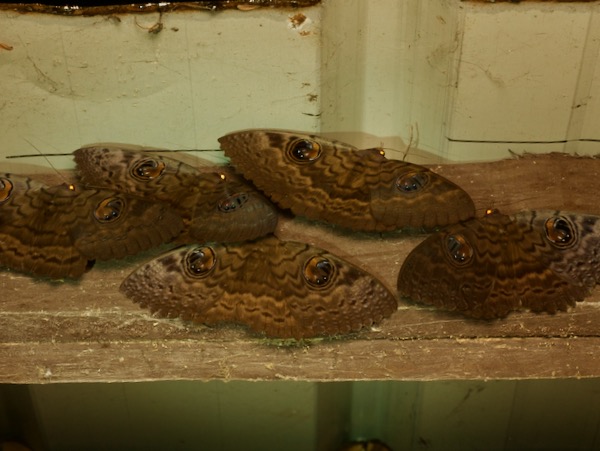
Walker's Owl,
Erebus walkeri
We found several small utility buildings in the forest that were covered with large spider webs occupied by correspondingly large spiders. Naturally, we referred to these as "spider houses". Two of the spider houses featured agglomerations of these moths under the eaves. Why do they agglomerate so? You tell me.
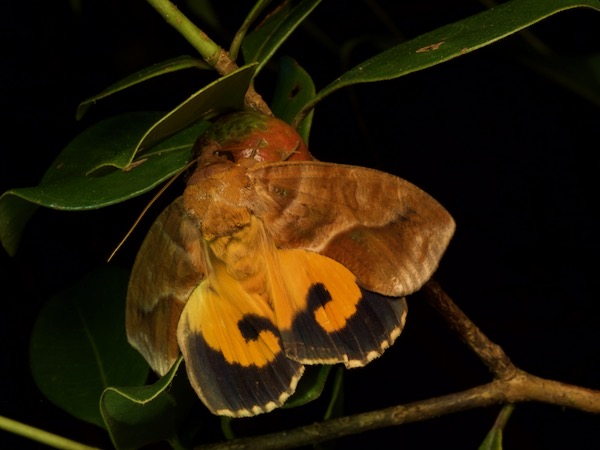
Common Fruit-piercing Moth,
Eudocima phalonia
Note that it is in fact piercing a fruit. Also, if you stare hard enough at the orange markings, you can see them as the curled arms of a body builder such as Ahhnold. And you won't be able to unsee that.
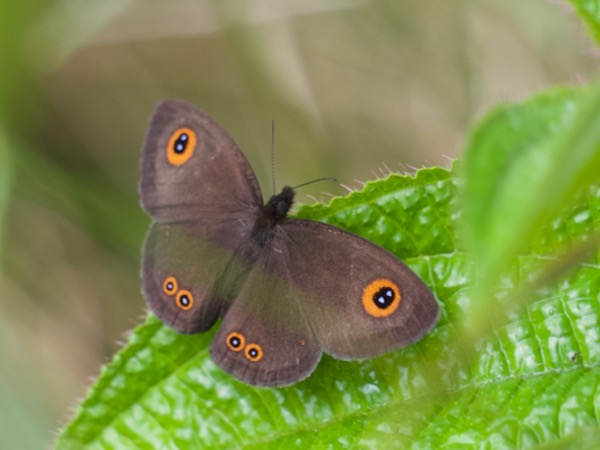
Strabena sp
Strabena includes a number of species that I don't know how to distinguish. They all look approximately like this.
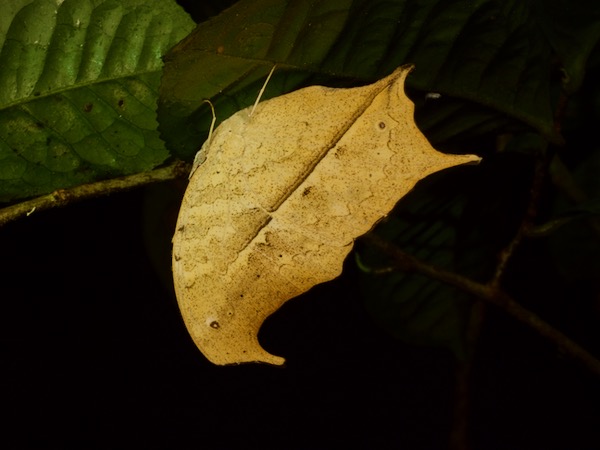
Precis eurodoce
This is among your finer dead-leaf imitations. It seems like it would work slightly better if these butterflies only rested on plants with dead leaves though.
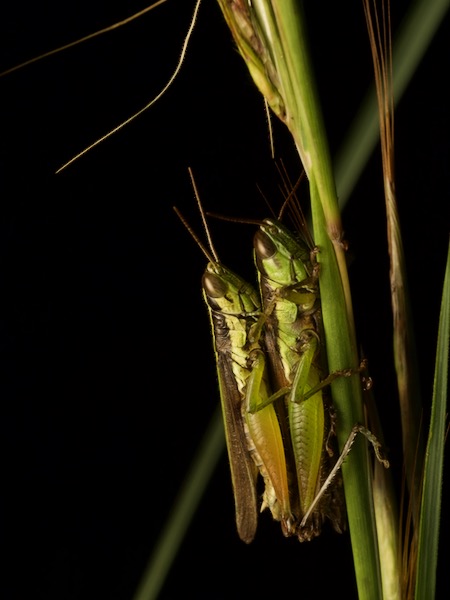
Spine-kneed Grasshoppers,
Oxya hyla
Oxya hyla has the distinction of being the grasshopper species consumed by people in the most localities across Madagascar according to
a 2019 study.
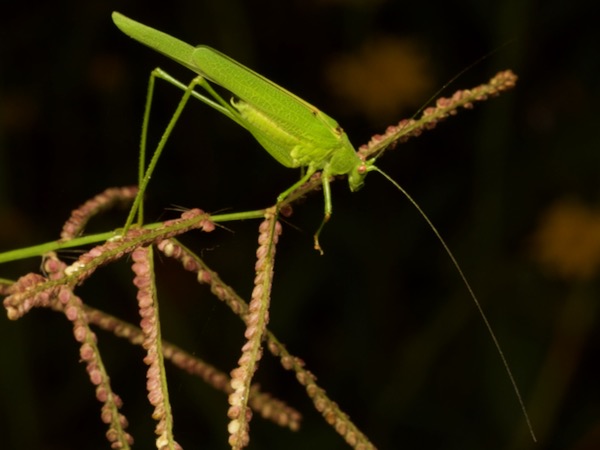
Sickle-bearing Leaf Katydid,
Phaneroptera sparsa
It's a katydid! It's leaf-colored and sort of leaf-shaped! It bears a sickle! What more can be said?
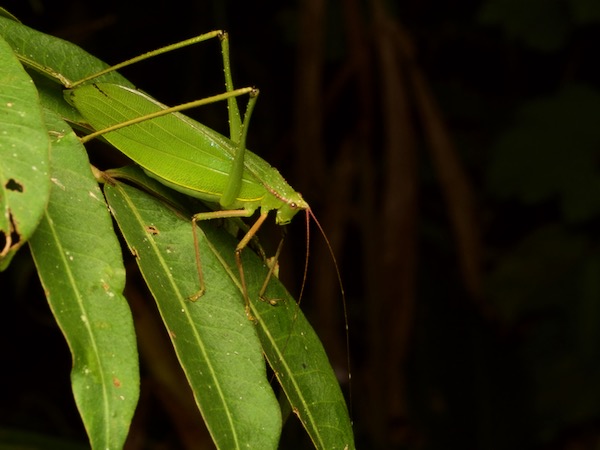
Cosmozoma doenitzi
This one is considerably more leaf-shaped than our friend Phaneroptera sparsa. Alas, it bears no sickle.
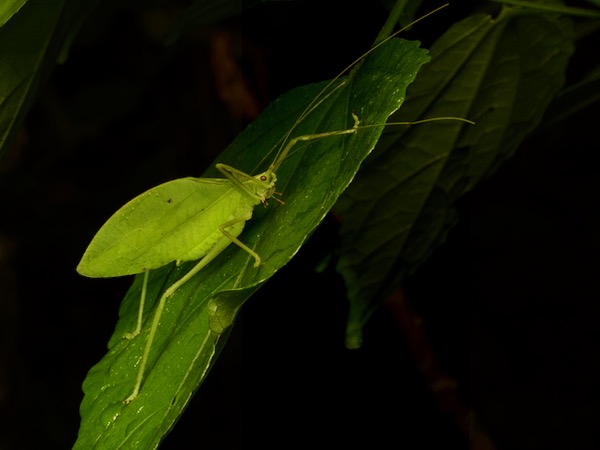
Sikoriella bimaculata
Even more leaf-shaped than the last two; like Cosmozoma, it remains sickle-free.
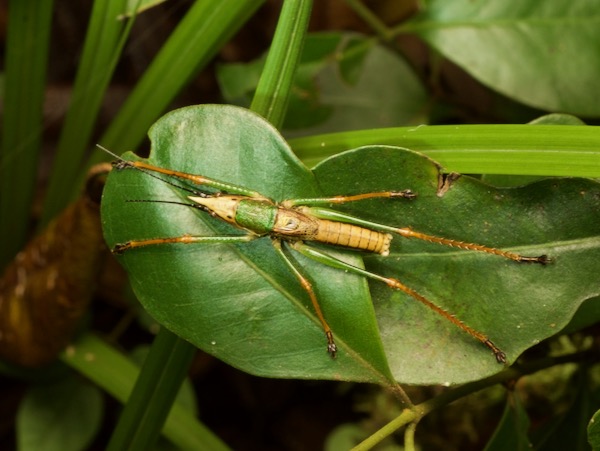
Euconchophora sp
To me, this looks like a robot katydid. But I have been known to be incorrect at times. Three species of
Euconchophora were described in the late 19th century. This one looks like a close match for
Euconchophora infuscata, but maybe the other two species look very similar; there are no online photographs of them.
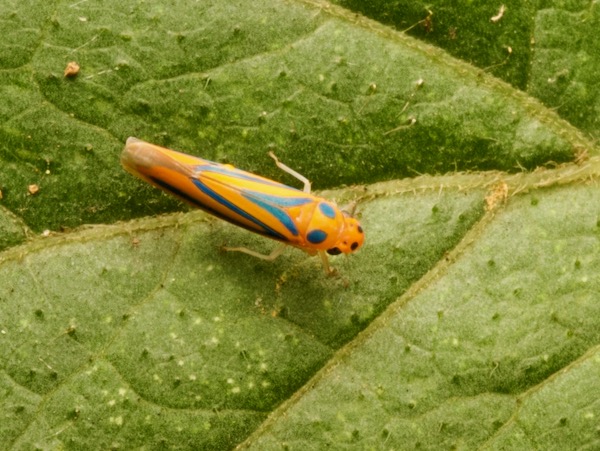
A beautiful, tiny leafhopper, Madranga segnita
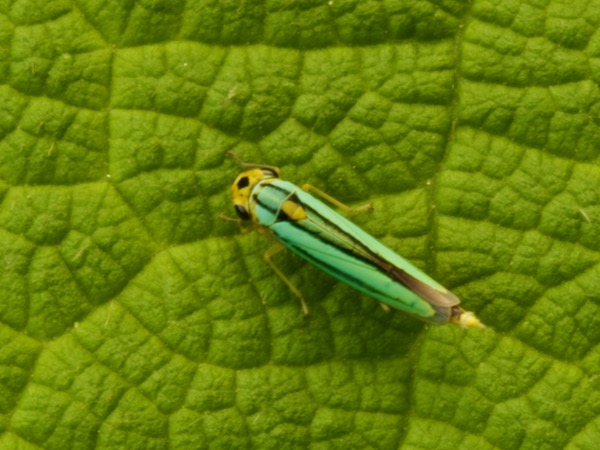
Same idea, different species: Macumada tergiplagatula
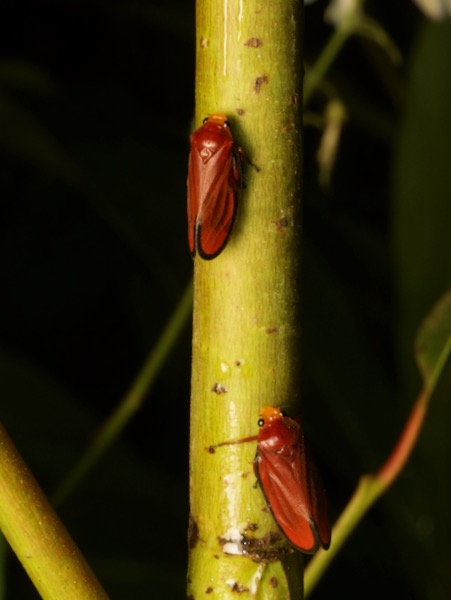
Amberana marginata
These are in the family Cercopidae, a.k.a. Froghoppers. Kind of a silly name, but I like it.
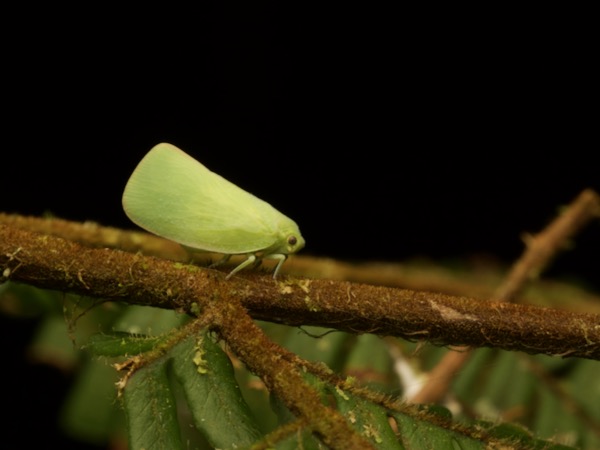
Flatopsis nivea
No froghopper here; this is in the family Flatidae, a.k.a. Flatid Planthoppers. "Flatid" sounds like an insult, but doesn't have any meaning that I could discover outside of the realm of planthoppers.
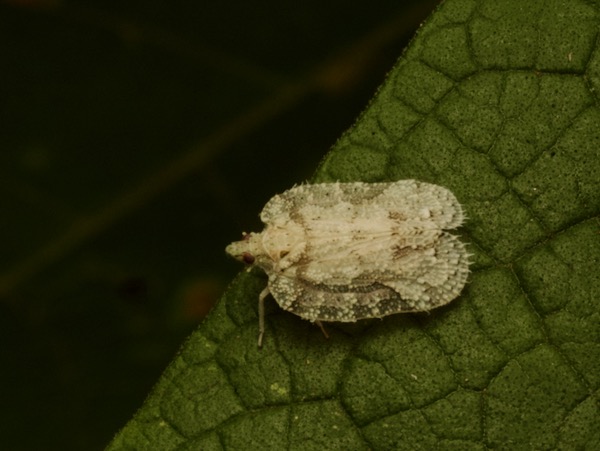
Flatoidinus sp
Another flatid planthopper, with quite a different shape. This one doesn't look like it would be as good at hopping, but I performed no corroborating experiments.
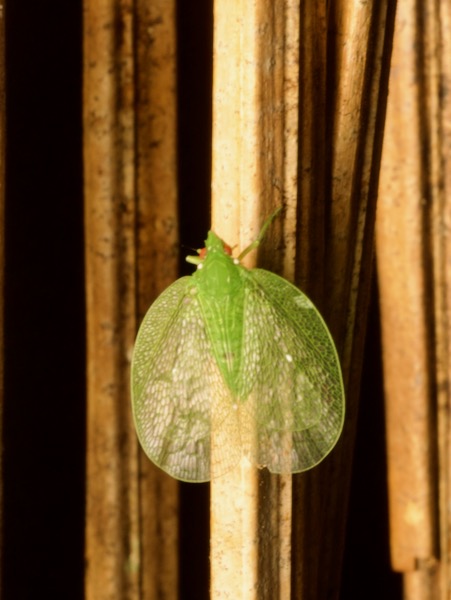
Infraorder Fulgoromorpha
This is a very cool-looking hopper of some sort, but I've been unable to narrow it down at all.
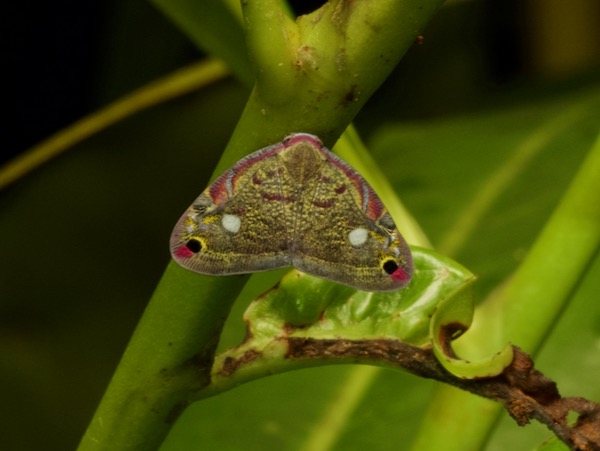
Unidentified planthopper, family Ricaniidae
This gorgeous hopper initially tricked us into thinking it was a colorful moth. It might be in the genus Ricania, but then again it might not be. (Information value of that last sentence is near zero, I know. But not quite zero because you might not have known that Ricania is a genus of planthoppers in the family Ricaniidae.)
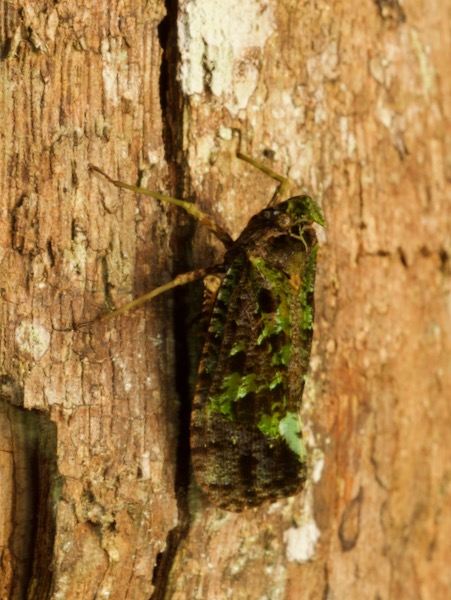
Belbina recurva
One last interesting hopper, this one in the family Fulgoridae, a.k.a. Lanternflies.
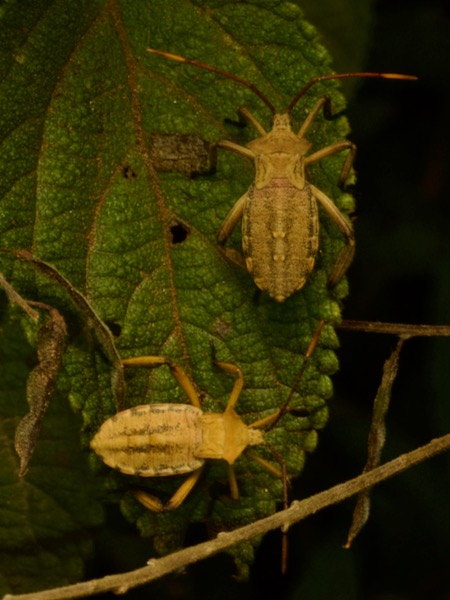
Unidentified leaf-footed bug nymphs, subfamily Coreinae
Something about these bugs brings to mind M.C. Escher.
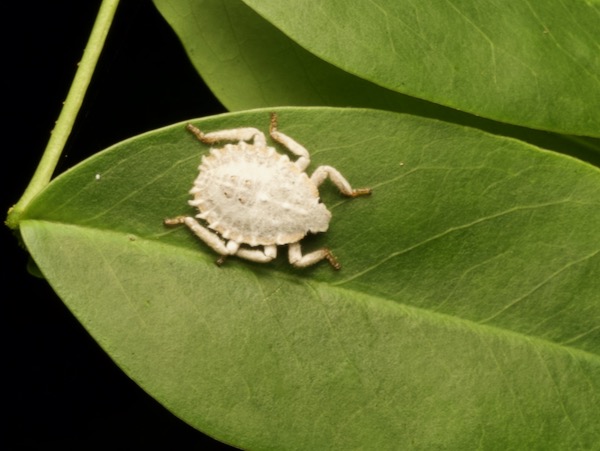
Unidentified true bug, superfamily Pentatomoidea
I don't know what the heck this thing is, but it looks cool. Those cute li'l human-like arms and legs!
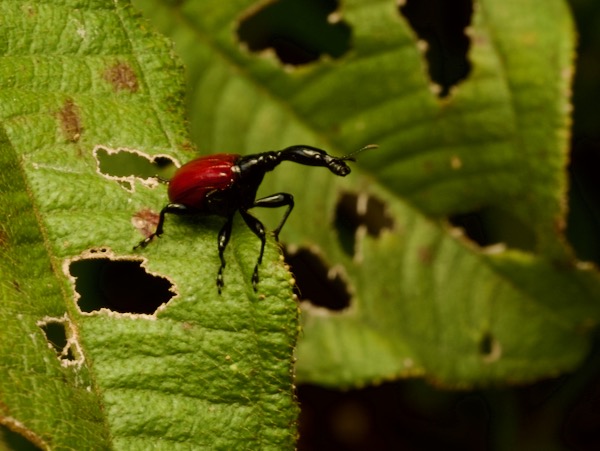
Giraffe Weevil,
Trachelophorus giraffa
Madagascar's most famous beetle, and probably most famous invertebrate, is renowned for its extra-long neck. You can tell this one is a female because although its neck is long, it is not crazy long.
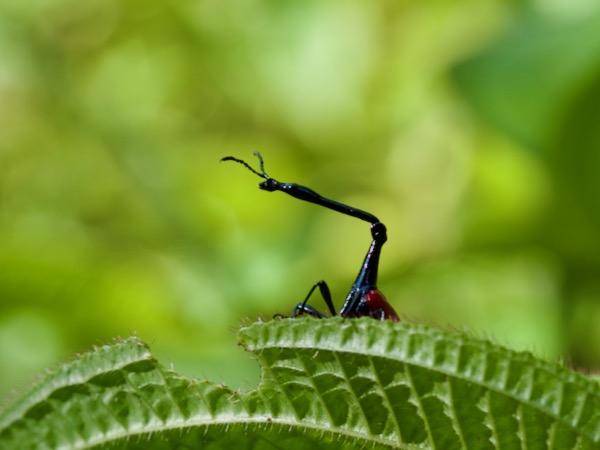
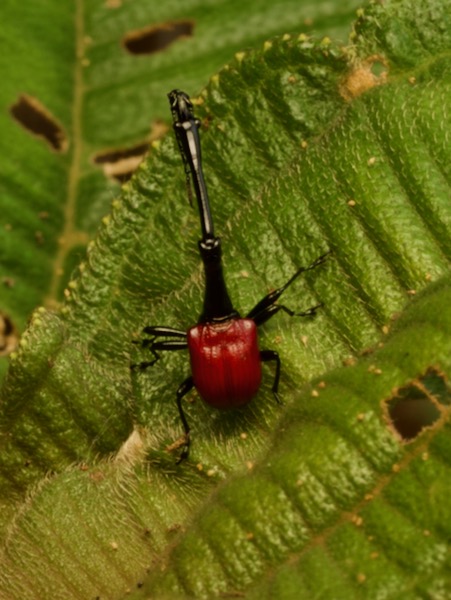
Giraffe Weevils,
Trachelophorus giraffa
These are males, with the crazy long necks. Several other Madagascar species of Trachelophorus exist, but none of them grow their necks quite this long.
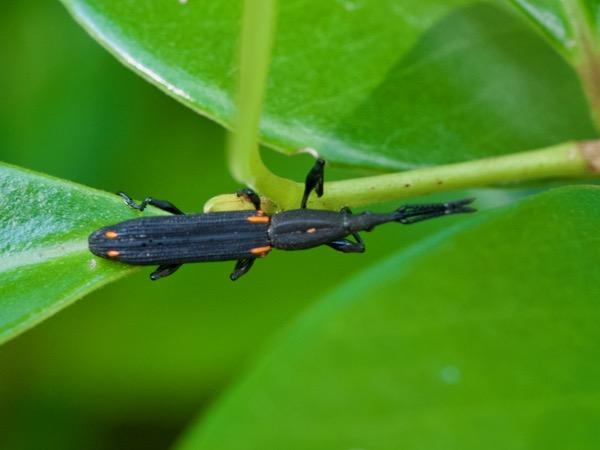
Zetophloeus pugionatus
Trachelophorus are fine weevils, but by no means the only interesting weevils we saw. I like this stylish extended model.
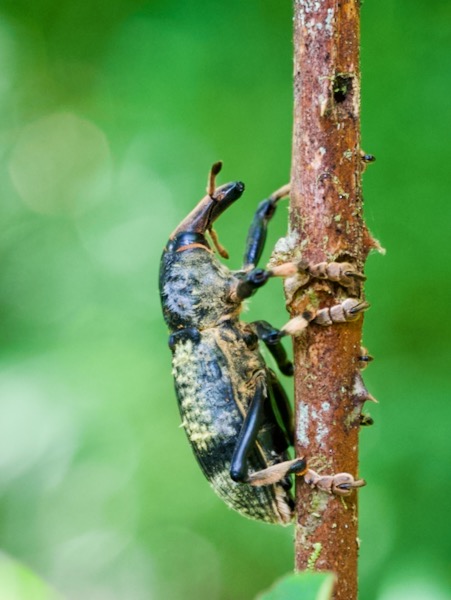
Lixus sp
We saw a number of large weevils in the genus Lixus near Andasibe and elsewhere. Unfortunately getting those IDs down to species level is not easy even for weevil experts, and I am not a weevil expert.
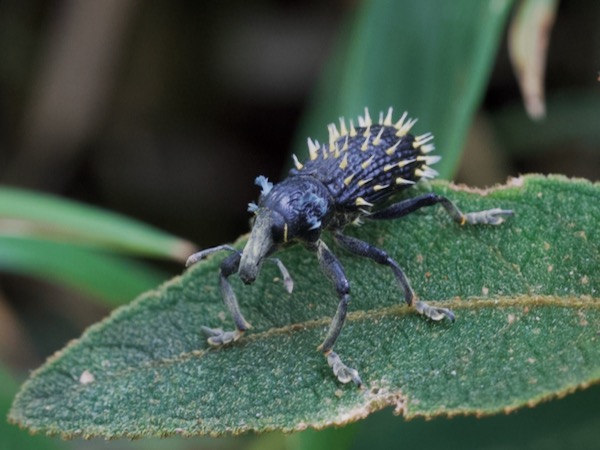
Lixus sp
Even being covered with punk rock spikes isn't enough to make this weevil easy to identify, as several Madagascar species share this fashion choice.
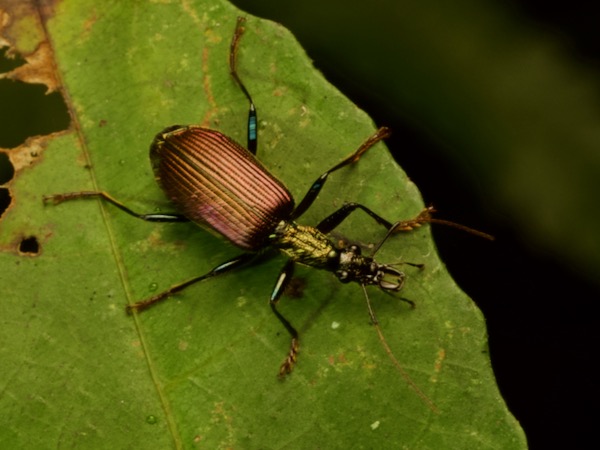
Nesiodrypta sp
I can't resist a shiny beetle.
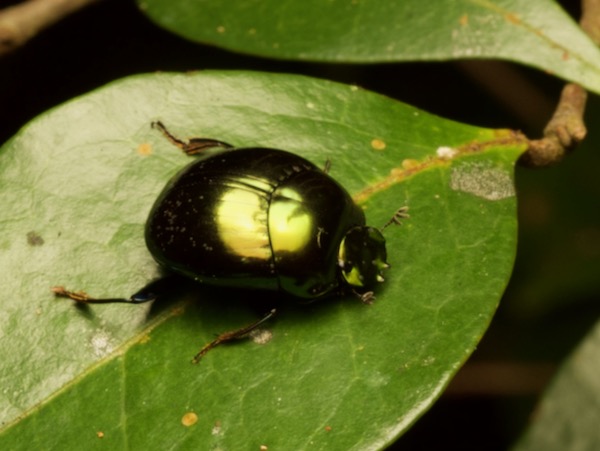
Epilissus splendidus
This one is even shinier. I photographed many of these beautiful scarab beetles (more specifically, dung beetles), all of them sitting awkwardly on leaves at night.
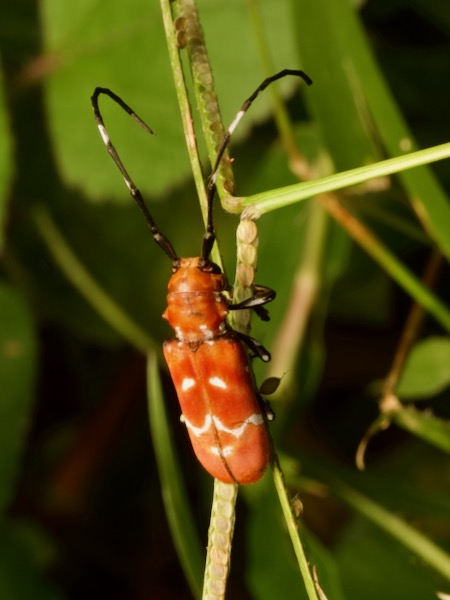
Callimation venustum
When I saw this long-horned beetle clinging to a blade of grass, I confidently declared it Beetle of the Day, though the day was still young. No challengers arose to dare contest this honor.
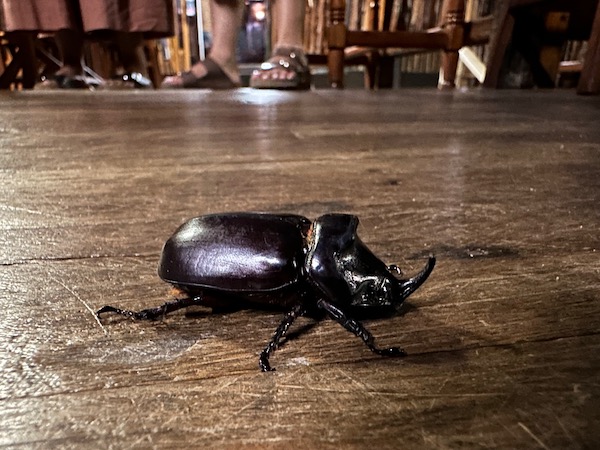
Oryctes sp
This large and heavy rhinoceros beetle dramatically clunked onto the dining room floor in the middle of our breakfast.
We were lucky to see a wide variety of mantises in this part of Madagascar. Here are a few of my favorites. None of them are identified all the way to species level.
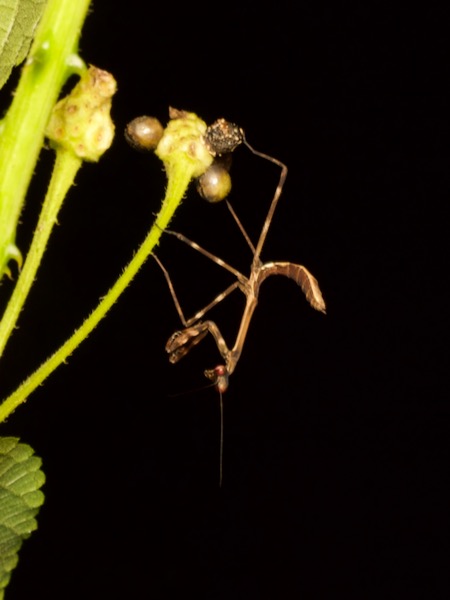
Tisma sp
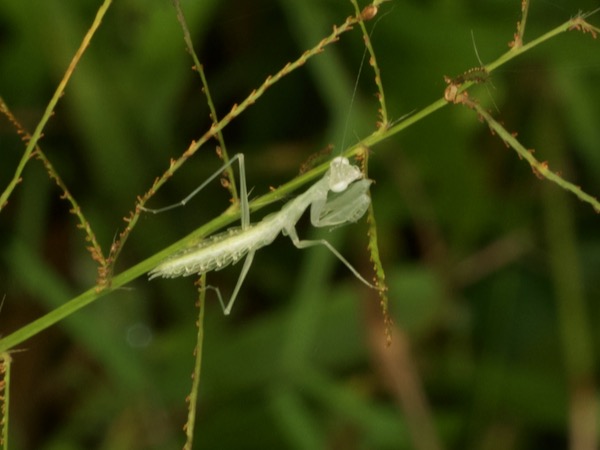
Family Nanomantidae
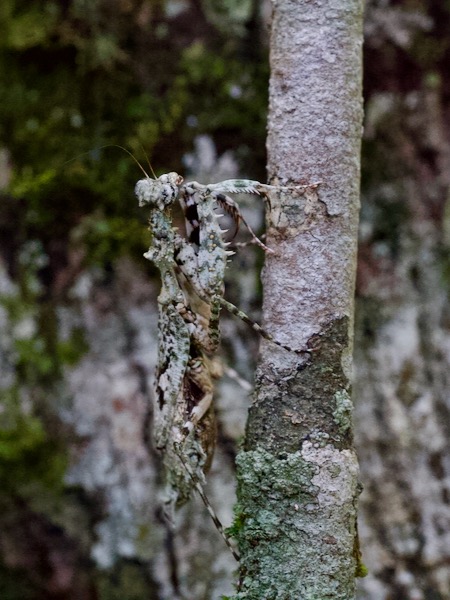
Majanga sp
I am also always on the lookout for phasmids, a.k.a. stick insects. Here are a few of the better ones from this area.
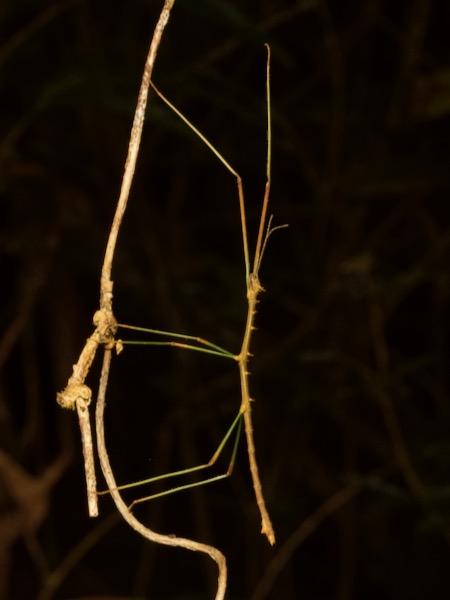
Cirsia sp
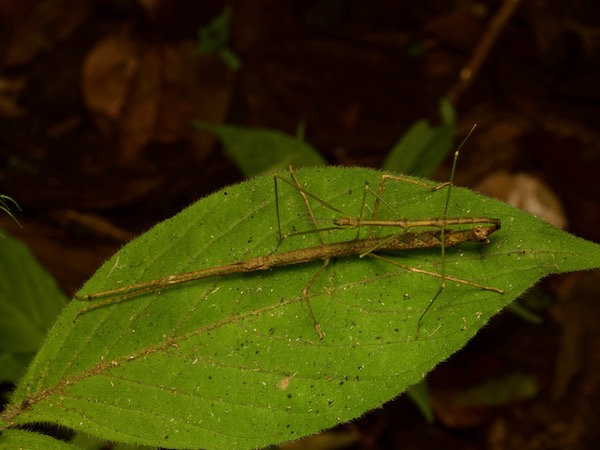
Tribe Leprodini
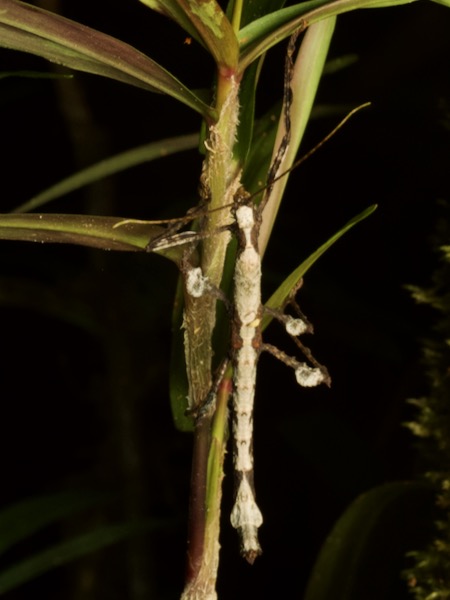
Subfamily Anisacanthinae
José pointed this one out to me. At first we thought the white color was a fungus,
but it is so symmetrically distributed that we decided it must be part of the insect. Perhaps it has evolved to appear as if it is infected by fungus so the phasmid-snackers will leave it alone.
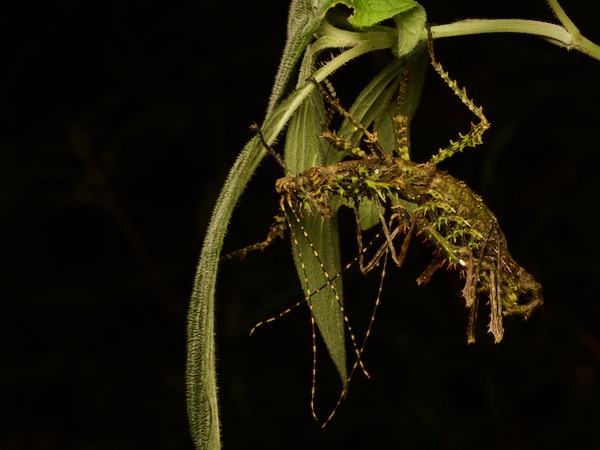
Parectatosoma sp
It took my brain several seconds to understand what I was seeing here, what with all the legs and spikes and banded antennae and such.
Spiders! Who doesn't love a nice spider? (Don't answer that.) Here are a few of the nicest ones I saw around Andasibe.
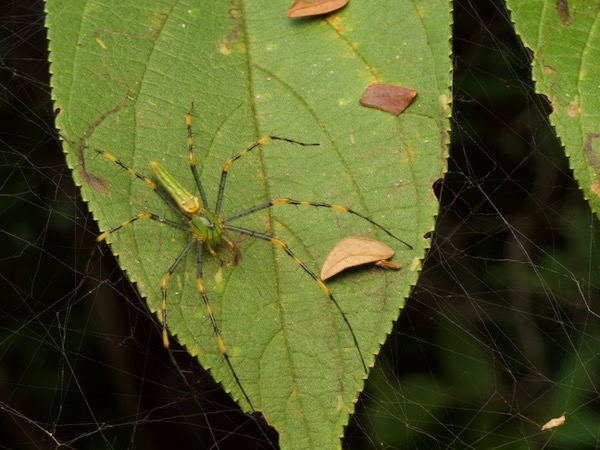
Peucetia madagascariensis
Madagascar houses two similar species of lynx spider, Peucetia madagascariensis and Peucetia lucasi. I am told that some spider authorities doubt that they are separate species, but if they are then I think this one is P. madagascariensis due to her strongly banded legs and details of her abdominal pattern. I know this one is female because we came past this same spot later on and I saw that the back of the leaf was covered with adorable little spiderlings.
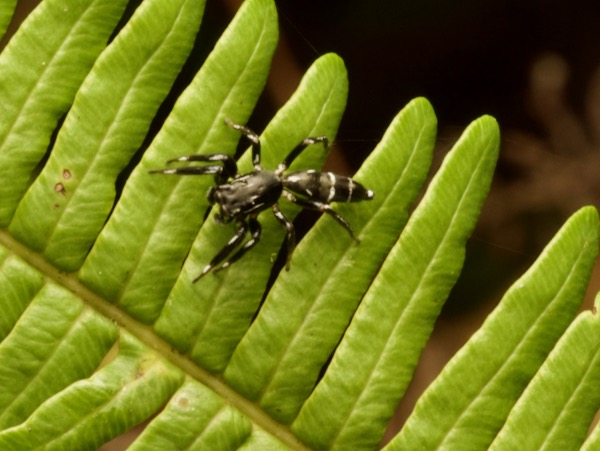
Hispo sp
Hispo jumping spiders are ant mimics. Indeed, I thought this was an ant when I first glimpsed it.
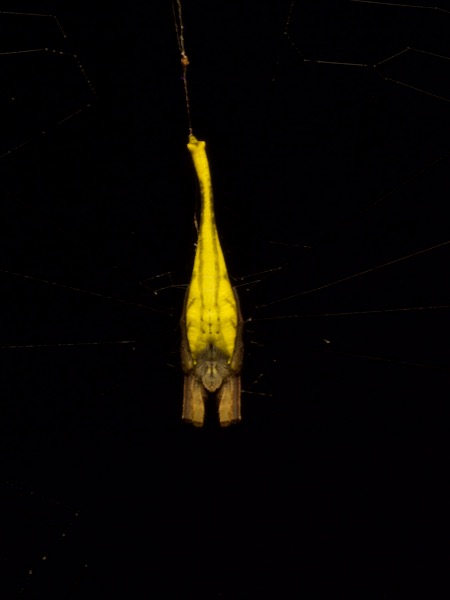
Scorpion-tail Spider,
Arachnura scorpionoides
Only female Arachnura have the long weird "tails" as shown here. I don't know what advantage this odd feature provides.
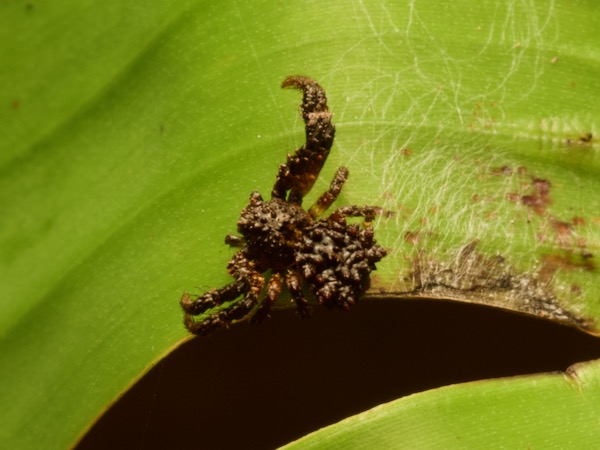
Wrinkled Birddung Crabspider,
Phrynarachne rugosa
José found this bird-poop-mimicking spider crawling on his arm while we waited out some rain before heading into the forest to look for chameleons. (This is not José's arm, in case you were wondering.)
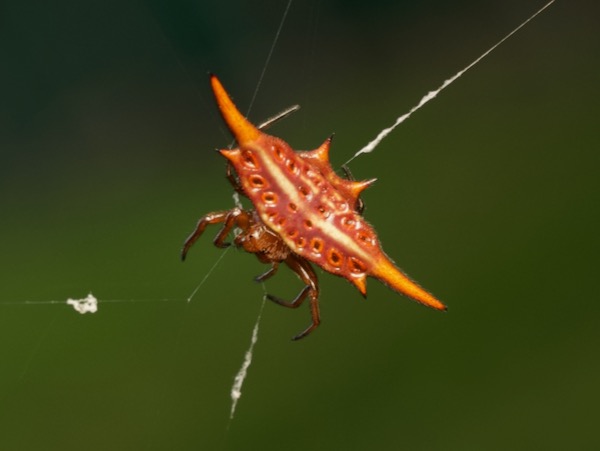
Mediumwing Kitespider,
Gasteracantha versicolor
Quite common and quite distinctive.
On my previous trips to Madagascar I had seen the iconic Madagascar Giant Fire Millipedes, but had not seen any of the equally iconic Giant Pill Millipedes. We made up for that lack this time.
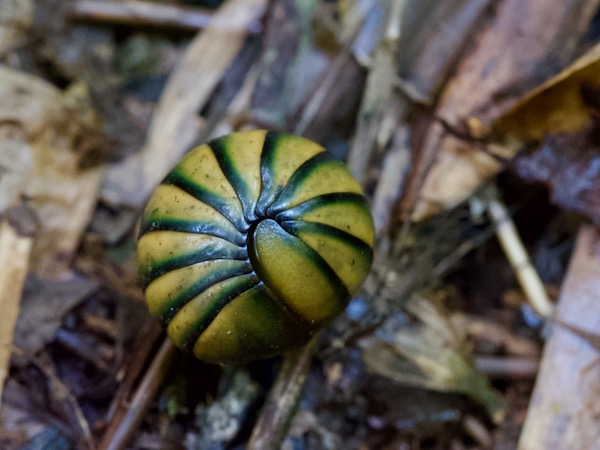
Zoosphaerium sp
These millipedes look and behave like giant woodlice, which are also called roly-polies, pillbugs, and a variety of other names. (Woodlice are isopods, a different group of animals than millipedes.) Like those animals, pill millipedes will quickly curl up into a ball for self-protection when disturbed. This one was perhaps the size of a ping pong ball. I'm not sure which of the numerous Zoosphaerium species this one belongs to.
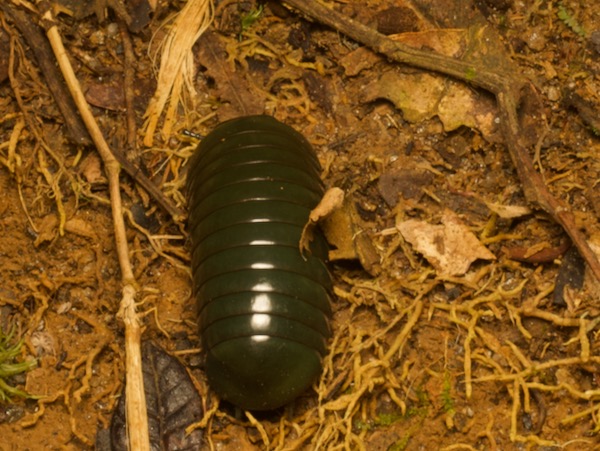
Madagascar Green-Emerald Giant Pill-Millipede,
Zoosphaerium neptunus
This one was easy to identify (for people who know the first thing about Giant Pill Millipedes, like Rainer, who also knows the second and third and subsequent things). Its deep green color and large size give it away; these are the largest of the Giant Pill Millipedes. When curled up they can be the size of a baseball. Seeing this one prompted Rainer to tell us about an unusual and mysterious behavior of this species: from time to time, on no fixed schedule and for no as-yet-known reason, they
aggregate in very large numbers in the forest. These are the only Giant Pill Millipedes known to gather like this. Wouldn't that be a sight to see?
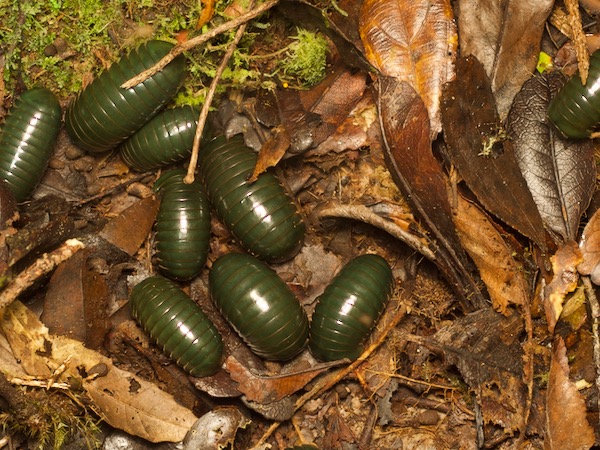
Madagascar Green-Emerald Giant Pill-Millipede,
Zoosphaerium neptunus
An hour or so later, we came across clusters of these millipedes.
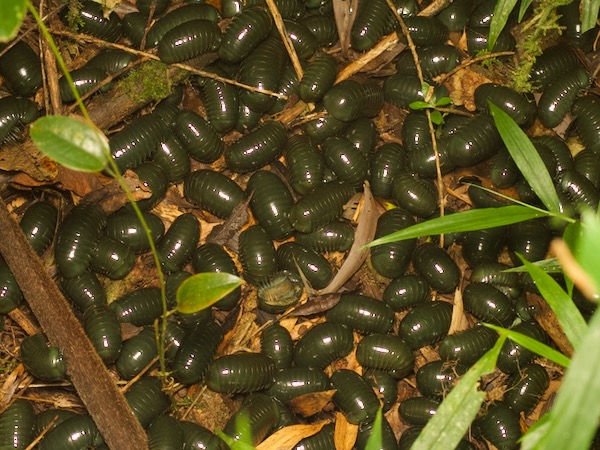
Madagascar Green-Emerald Giant Pill-Millipede,
Zoosphaerium neptunus
And a few minutes after that, we were surrounded by thousands of them, visible as far as the flashlight could shine.
While we had some free time to explore or rest, Mike ran into some random local guide on the road and went off on a bird-finding adventure in Analamazoatra, where he saw various legendary Madagascar endemics, including ground rollers and suchlike. I did no such thing, so I only saw birds that were willing to show up while we were herping in the forest or having breakfast on the lodge's outdoor dining area. This is one of my many excuses for not having many bird photos.
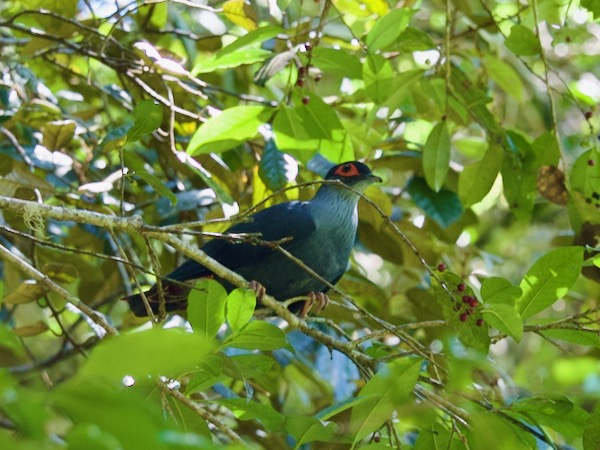
Madagascar Blue-Pigeon,
Alectroenas madagascariensis
This one put in an appearance in the forest.
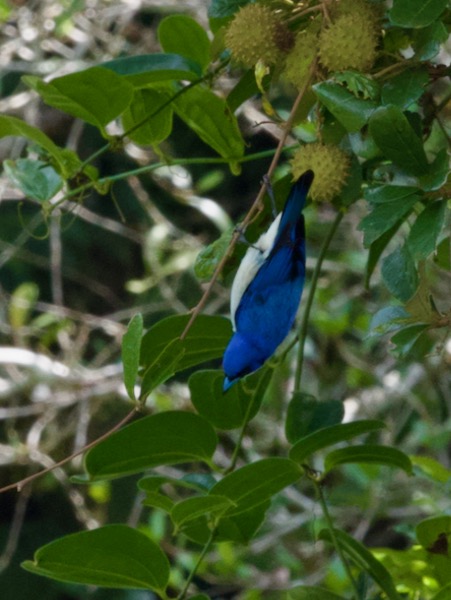
Blue Vanga,
Cyanolanius madagascarinus
This one hopped around in the vegetation during breakfast.
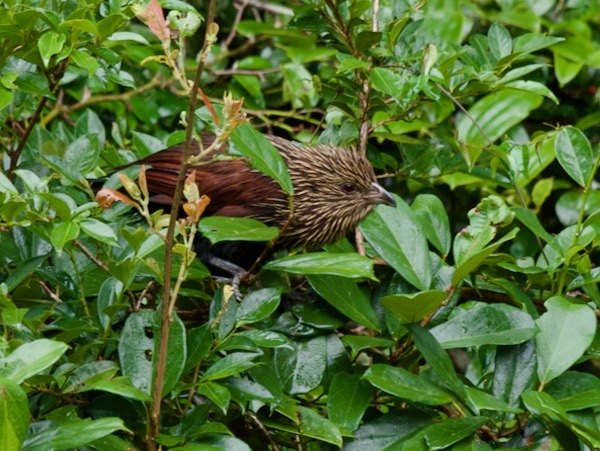
Madagascar Coucal,
Centropus toulou
Another breakfast bird.
We spent very little time specifically looking for lemurs, but this being Madagascar we still saw quite a few lemurs.
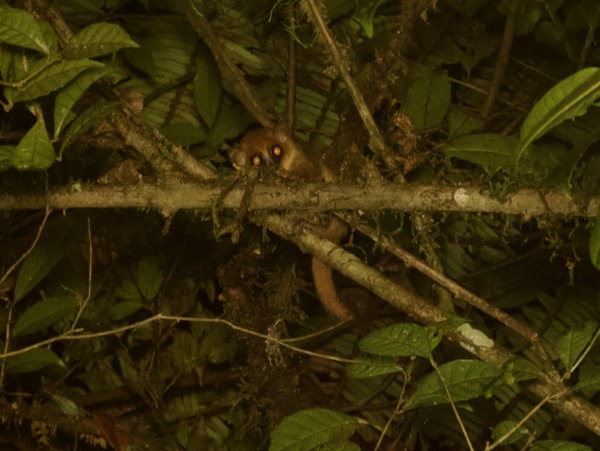
Goodman's Mouse Lemur, Microcebus lehilahytsara
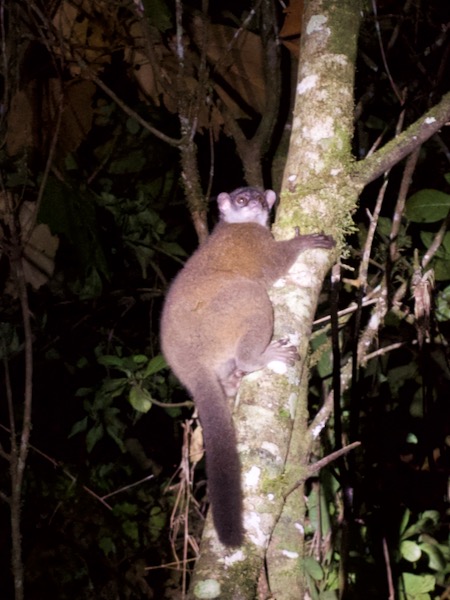
Weasel Sportive Lemur, Lepilemur mustelinus
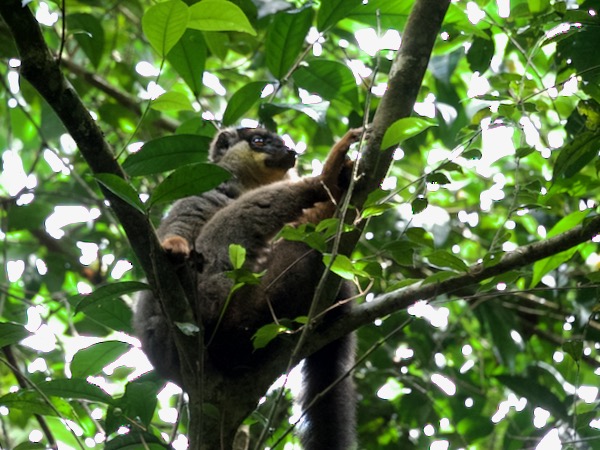
Common Brown Lemur, Eulemur fulvus
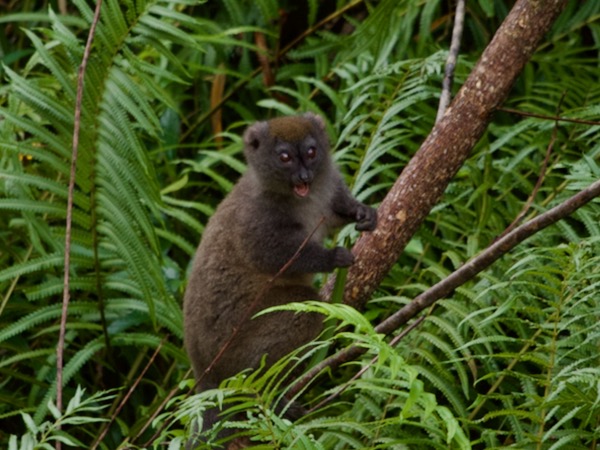
Eastern Lesser Bamboo Lemur, Hapalemur griseus
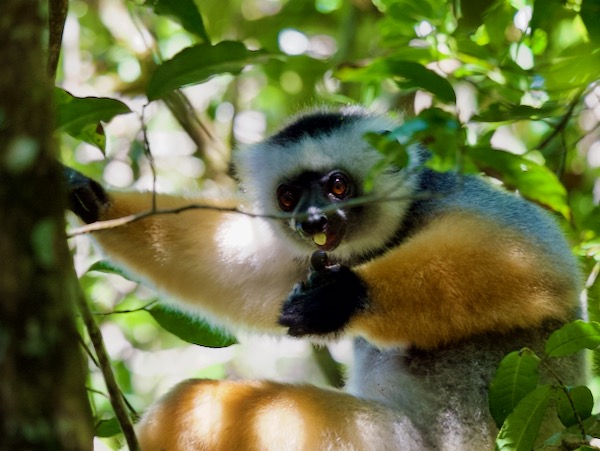
Diademed Sifaka, Propithecus diadema
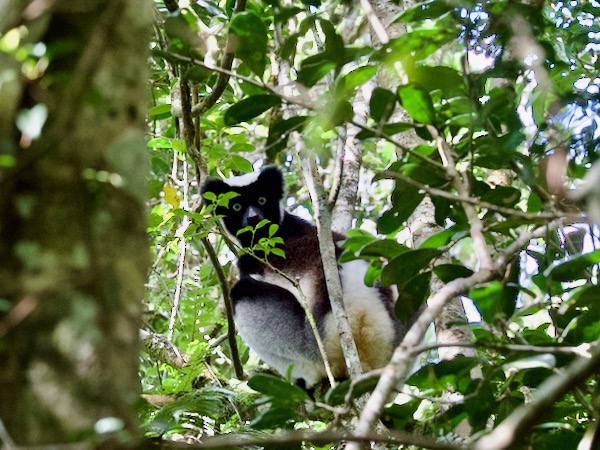
Indri,
Indri indri
Here it is, that largest of lemurs promised at the top of this page. They make the
most beautiful and ear-piercingly loud calls, among the loudest of any mammal. Rainer said that Howler Monkeys are technically louder, but I don't find the
calls of Howler Monkeys beautiful.
Our visit was past the end of the wet season, so it was not the time for maximum frogulation. Even so, we saw many wonderful frogs in the rainforest.
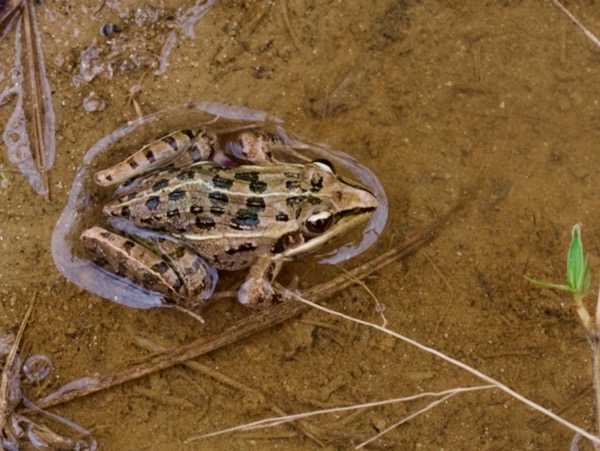
Mascarene Ridged Frog,
Ptychadena mascareniensis
You might recognize this standard water-frog-looking frog from Anjozorobe. We saw it here in Andasibe also, as well as later on at Ranomafana, Anja, and Isalo. Not a hard frog to find.
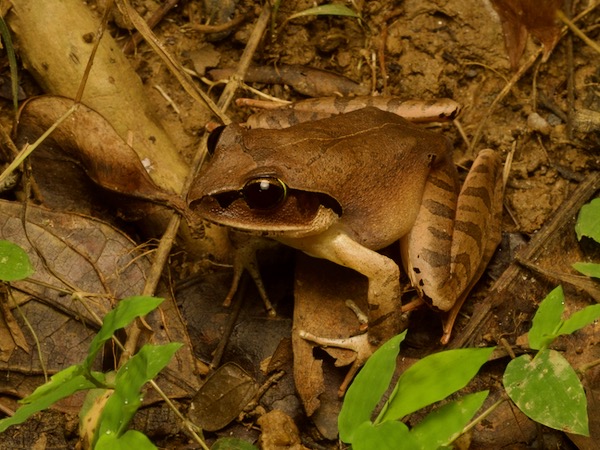
Madagascar Jumping Frog,
Aglyptodactylus madagascariensis
These leaf-litter-colored frogs would generally sit perfectly still in the leaf litter unless you got a little too close, at which point they would powerfully bound away. "Madagascar Jumping Frog" indeed.
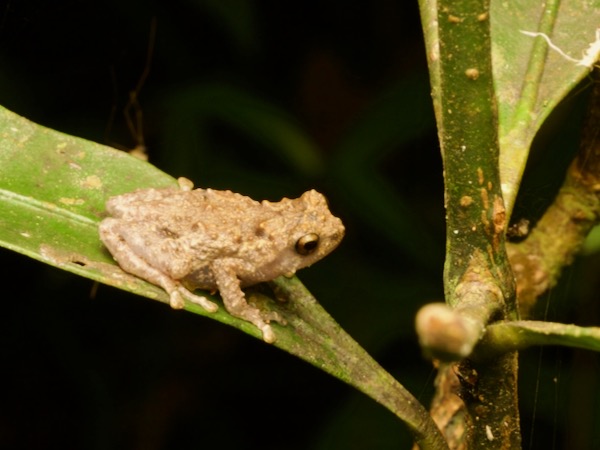
Boulenger's Climbing Frog, Anodonthyla boulengerii
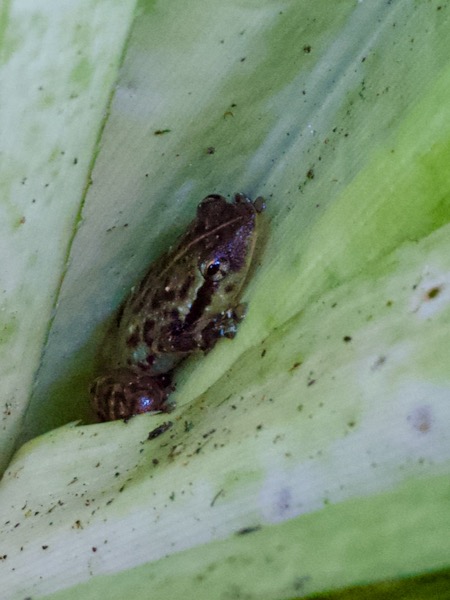
Ambatoharanana Whistling Frog, Cophyla tuberifera
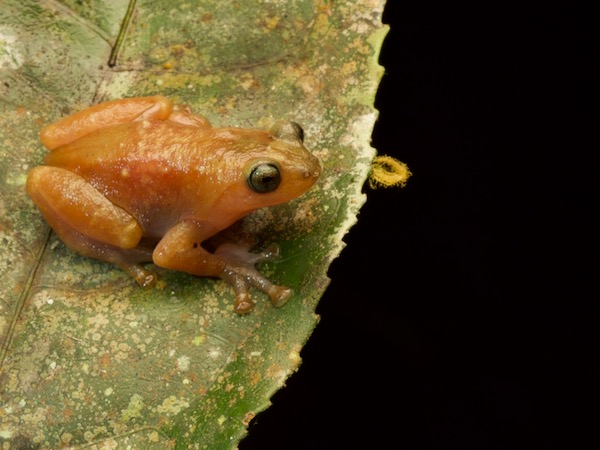
Cophyla sp
This frog seems very distinctive, with its orangey wrinkly wet-looking skin and blobby shape. It looks quite similar to what
Glaw and Vences 3rd edition illustrates as
Platypelis 5a. That pictured individual is from Ranomafana rather than Andasibe, but in any case nobody seems to have yet sorted out these frogs. Note that
Platypelis has since been subsumed into
Cophyla.
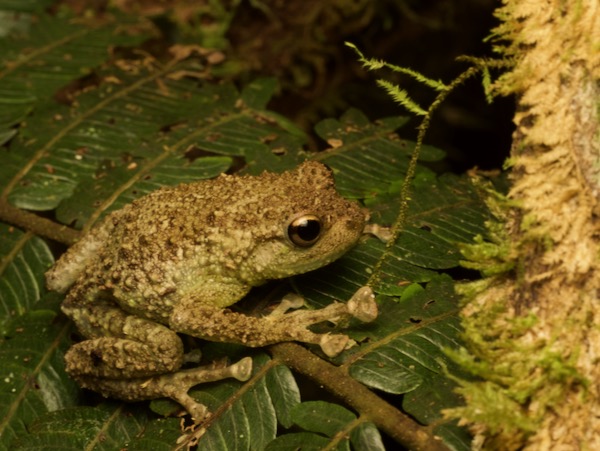
Boulenger's Giant Treefrog,
Cophyla grandis
Not a treefrog in the taxonomic sense, but rather an arboreal microhylid. But proud to be the largest of all strictly arboreal microhylids, so there's that.
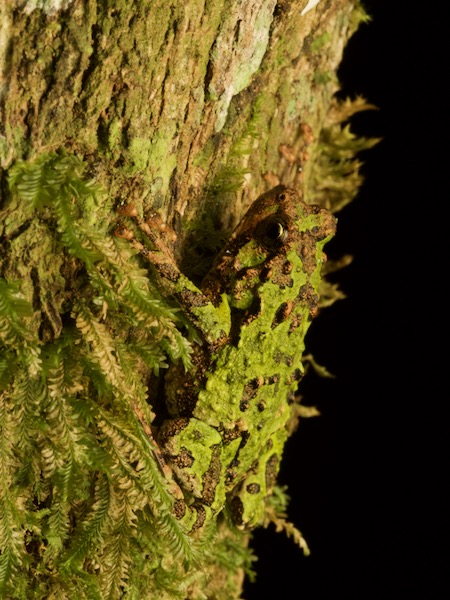
Marbled Rain Frog,
Scaphiophryne marmorata
These well-camouflaged microhylids that look like toads spend their days on the ground but sleep off the nights clinging vertically to the trunks of trees.
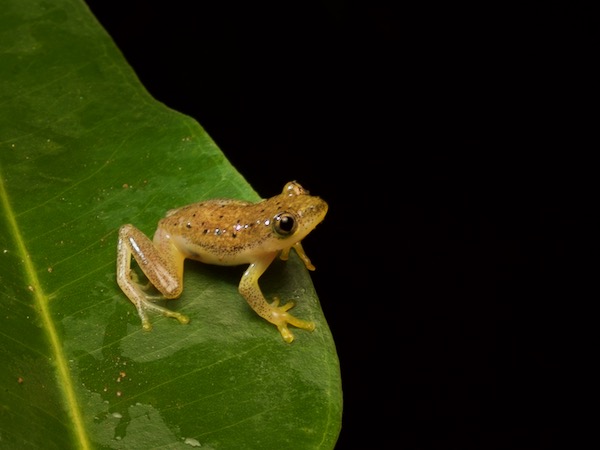
Andasibe Reed Frog,
Heterixalus punctatus
Heterixalus frogs are part of the arboreal frog family Hyperoliidae, which are mostly found in sub-Saharan Africa. This genus is exclusive to Madagascar though, where there are a dozen or so species. H. punctatus is the only species known from this area.
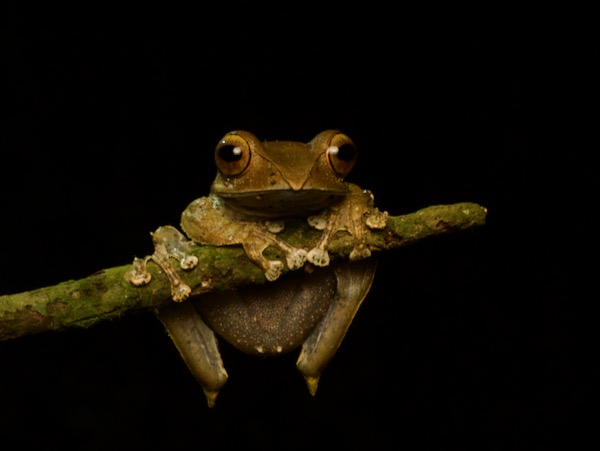
Madagascar Bright-eyed Frog,
Boophis madagasariensis
This large species was common at Anjozorobe and even more common at Andasibe.
Small to medium-sized Boophis species around Andasibe sported a wide variety of skin textures, eye colors, and skin colors, all in more or less the same basic treefrog shape.
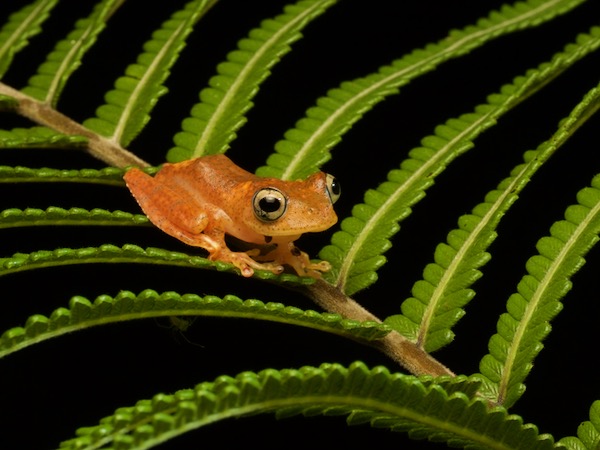
Red Bright-eyed Frog, Boophis pyrrhus
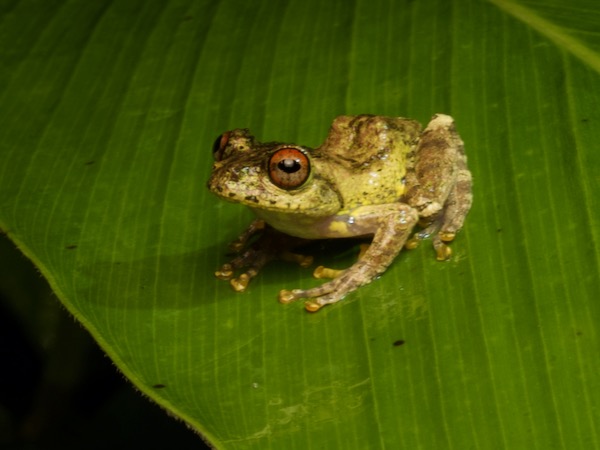
Warty Bright-eyed Frog, Boophis guibei
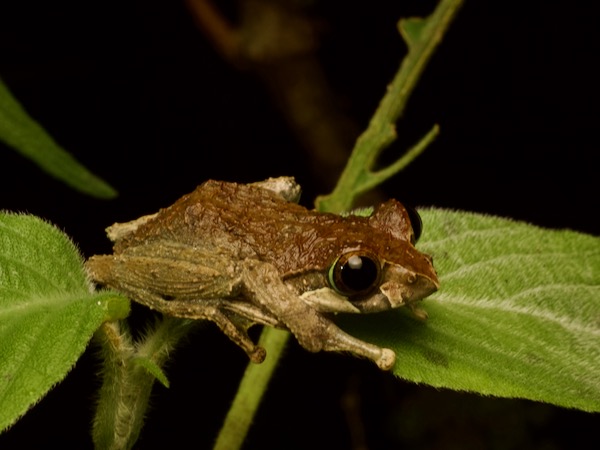
Reticulate Bright-eyed Frog, Boophis reticulatus
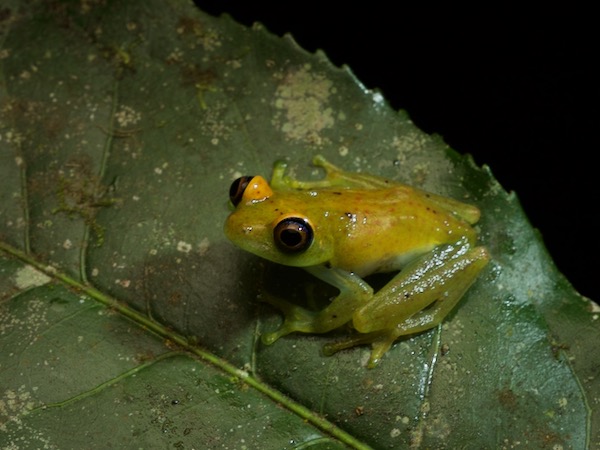
Green Bright-eyed Frog, Boophis viridis
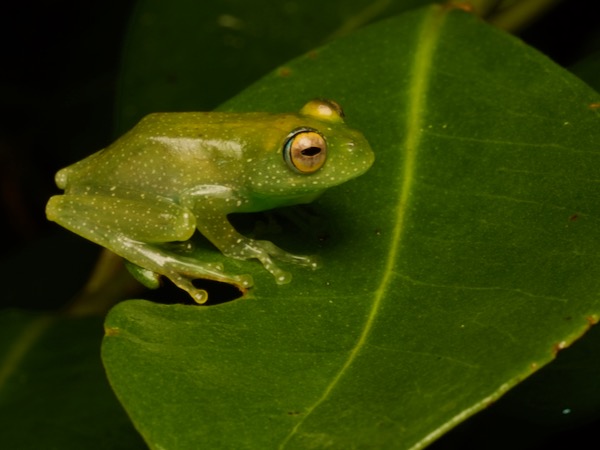
Spotted Bright-eyed Frog, Boophis albipunctatus
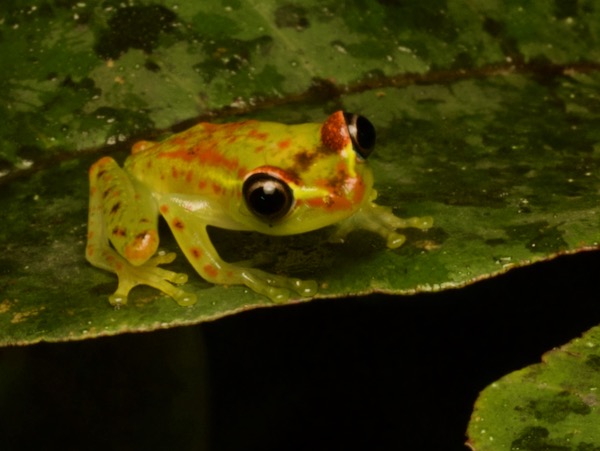
Bott's Bright-eyed Frog, Boophis bottae
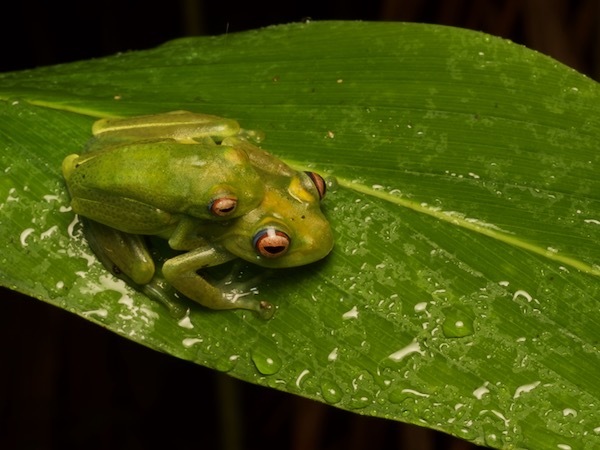
Ankafana Bright-eyed Frog, Boophis luteus
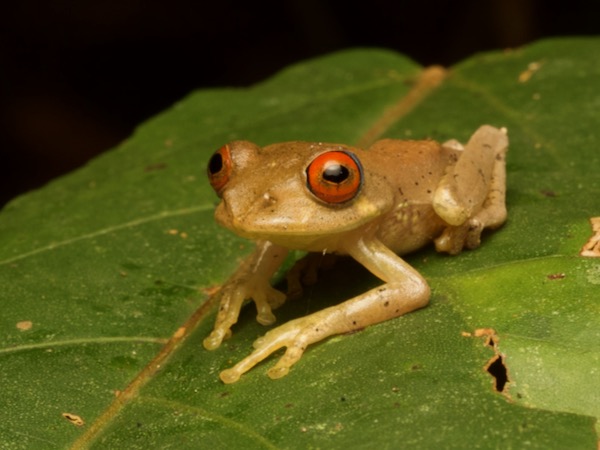
Böhme's Bright-eyed Frog, Boophis boehmi
Spinomantis frogs in the east and north of Madagascar are arboreal, treefrog-like frogs with dermal fringes and spines (hence the name). Some other non-arboreal, non-fringe-or-spine-bearing frogs in the south are also included in this group, but we didn't concern ourselves with those because we didn't see any. Keeps things simple.
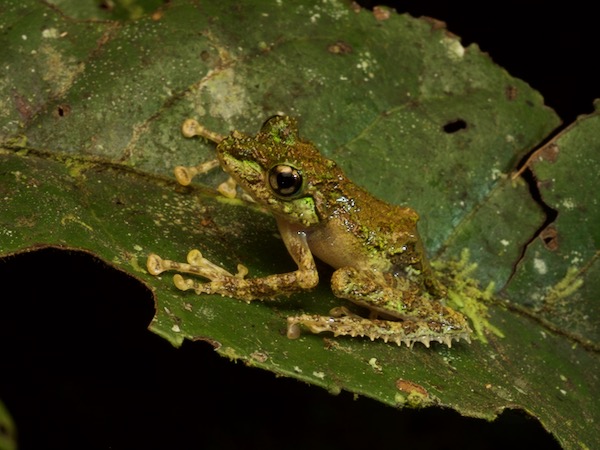
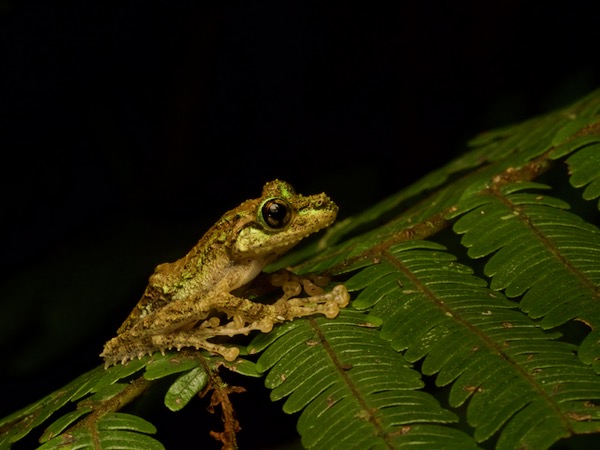
Anamalozoatra Madagascar Frog,
Spinomantis aglavei
We saw several individuals of this charismatic spiny frog in more than one forest. I hadn't seen any Spinomantis on my previous trips so I was very happy with this interesting species.
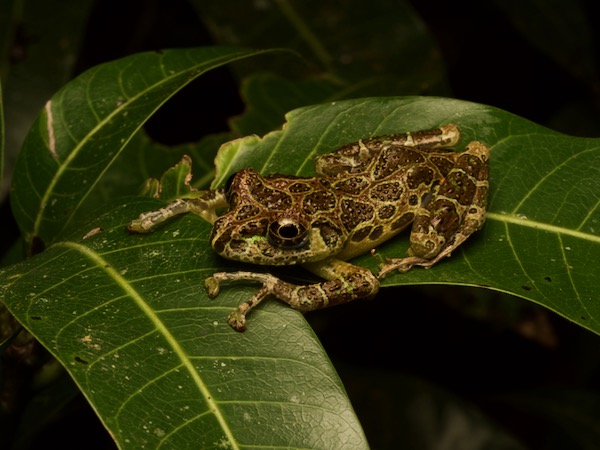
Peracca's Madagascar Frog,
Spinomantis peraccae
We were puzzled about this frog until we realized that there is one species of arboreal Spinomantis that lacks the fringes and spines, and this is that species. Normally the frog with fringes and spines would be objectively better than the frog without, but this one has such extra-cool patterning that I'm not so sure.
You might have thought that we had seen enough different frogs for one area, but there were still more frogs. Always more frogs. Imagine if we had come in the rainy season!
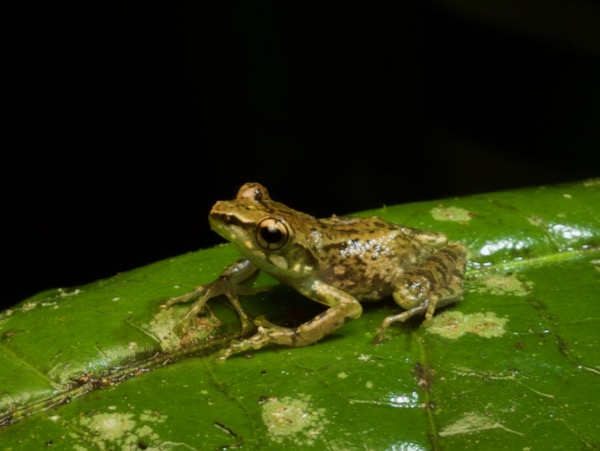
Free Madagascar Frog, Guibemantis liber
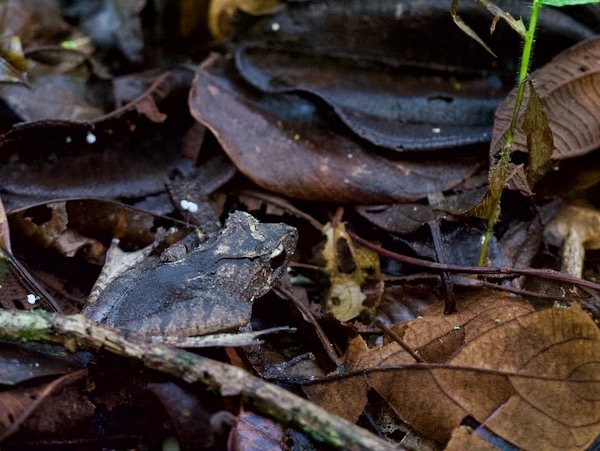
White Folohy Madagascar Frog, Gephyromantis luteus
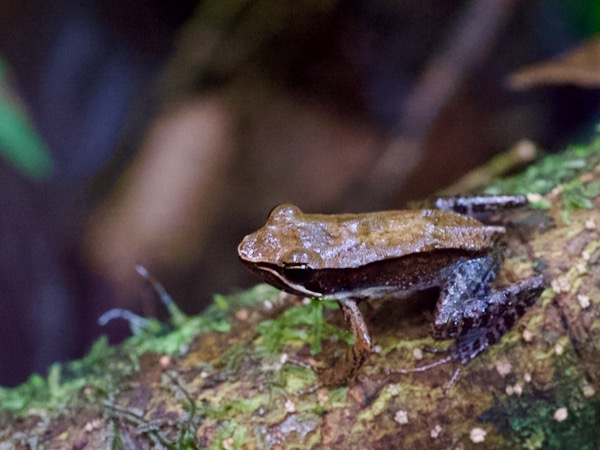
Eastern Madagascar Frog, Mantidactylus albofrenatus
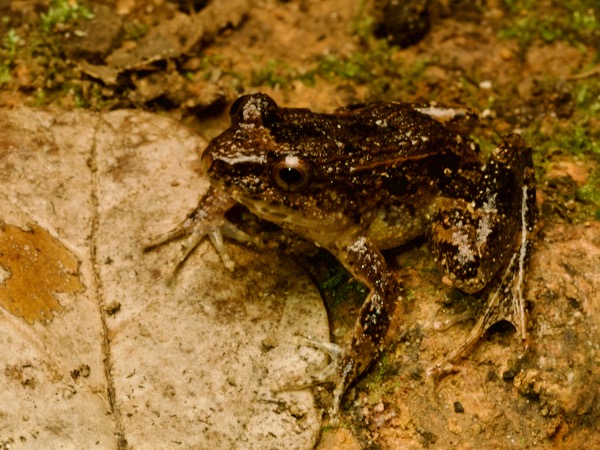
Betsileo Madagascar Frog, Mantidactylus betsileanus
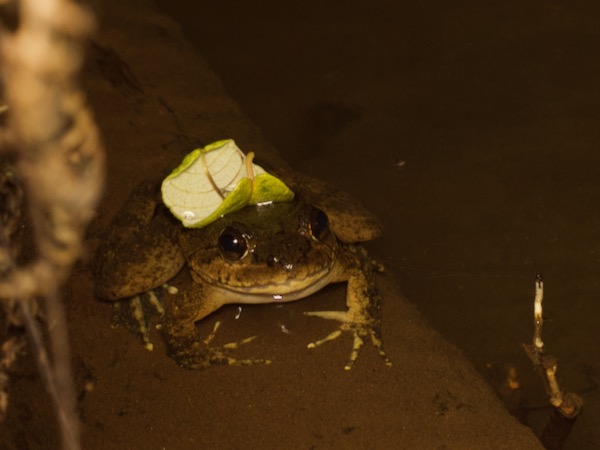
Grandidier's Madagascar Frog, Mantidactylus grandidieri
Five days into our Madagascar adventure and we had yet to see a snake. This wasn't a big problem, as Madagascar is known for incredible frog diversity and gecko diversity and chameleon diversity but not so much for snake diversity. Still, we were herpers and we would not be satisfied without any snakes at all. On the evening of the fifth day we were preparing to get into the Russian Tank and ride out to our night hike location, but we couldn't leave yet because José was missing. That darn José, keeping us from all the cool forest critters with his tardiness! A few moments later José showed up cradling this large boa, which he had found on the sidewalk between his room and the parking lot. We stopped whining about his tardiness.
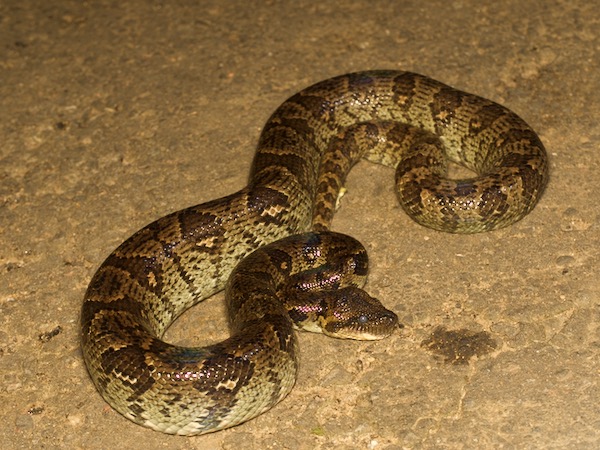
Madagascar Tree Boa, Sanzinia madagascariensis
The only other snake species we saw in the Andasibe area (not counting a couple of squished ones on the road) was this not particularly exciting but still serpentine one.
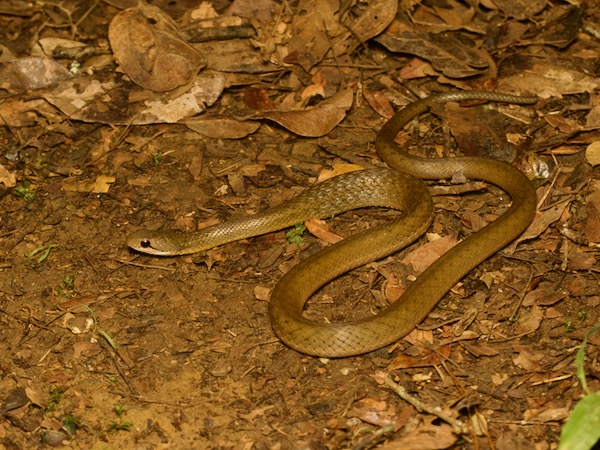
Forest Water Snake, Thamnosophis infrasignatus
What we missed in snake diversity near Andasibe we made up for in chameleon diversity. We saw fifteen species of chameleons in this area, and well over 150 individuals. Whee!
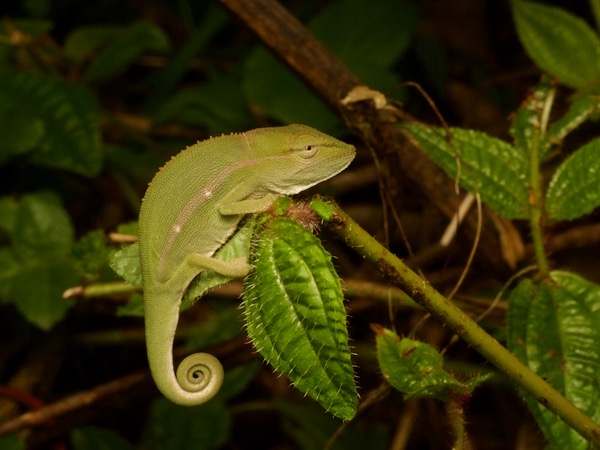
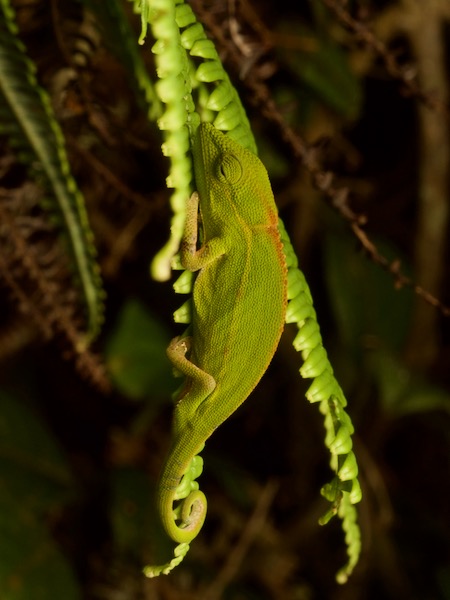
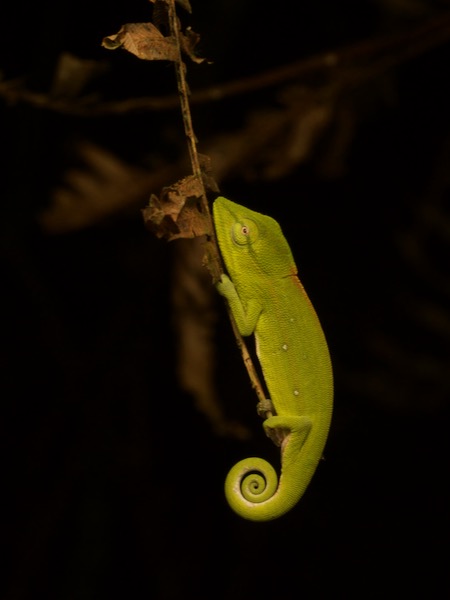
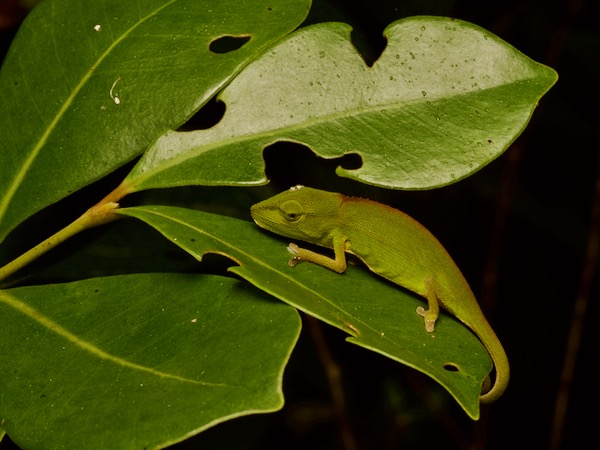
Perinet Chameleon,
Calumma gastrotaenia
As at Anjozorobe, Calumma gastrotaenia was by far the most commonly seen species, each one of these adorably small chameleons cuter than the next.
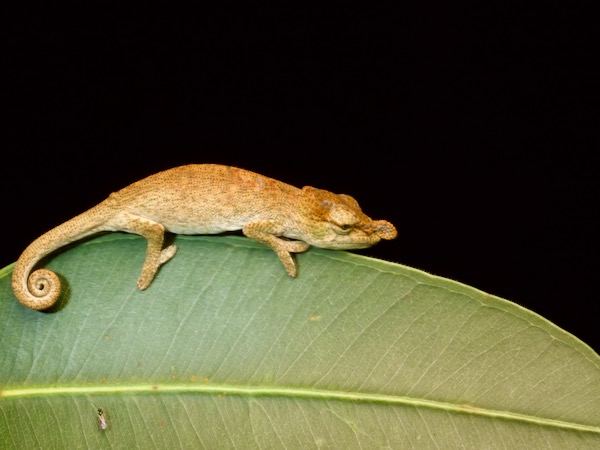
Andasibe Nosed Chameleon,
Calumma nasutum
Four of the chameleon species we saw here were little ones with silly nasal protuberances. This first one is the classic Calumma nasutum, which retained that name when numerous other species were split off from it.
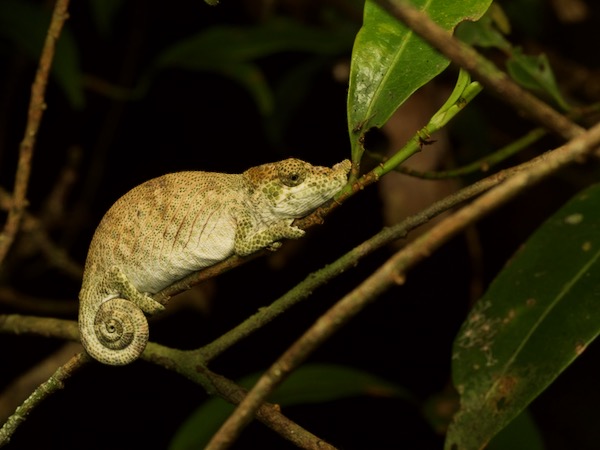
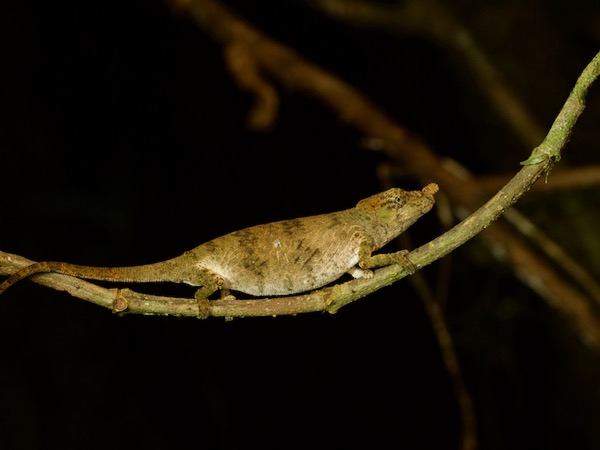
Angozongahy Nosed Chameleon,
Calumma emelinae
One of the species split off from Calumma nasutum, Calumma emelinae has distinctive scale patterns that help distinguish it.
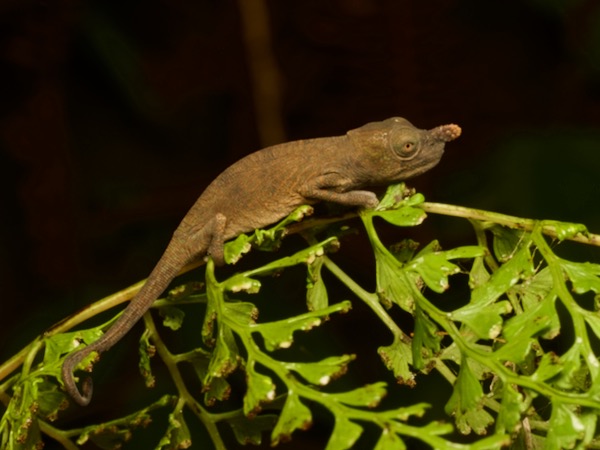
Lance-nosed Chameleon,
Calumma gallus, juvenile
We visited a particular reserve primarily to find this species. We were worried that a late afternoon rainstorm would mess with our ability to find them, but within a few minutes of starting our hike after the rain died down we found one, then another, then another and another and another. When Calumma gallus is young it doesn't look much different than Calumma nasutum or Calumma emelinae.
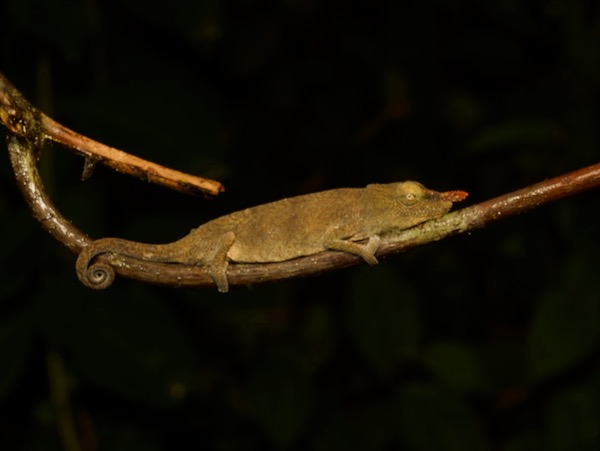
Lance-nosed Chameleon,
Calumma gallus, adult female
Adult females have longer, pointier, and more colorful nasal appendages than Calumma nasutum and such.
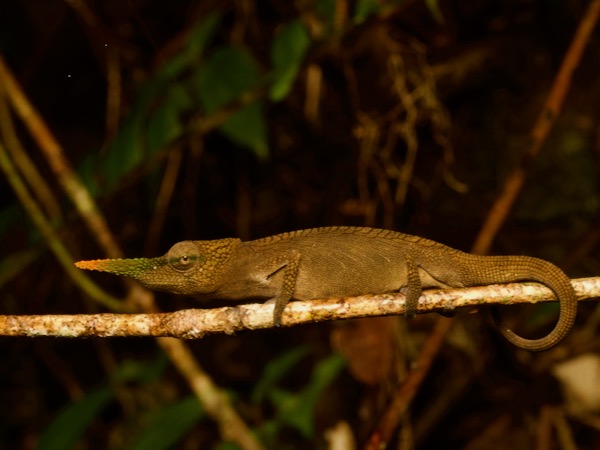
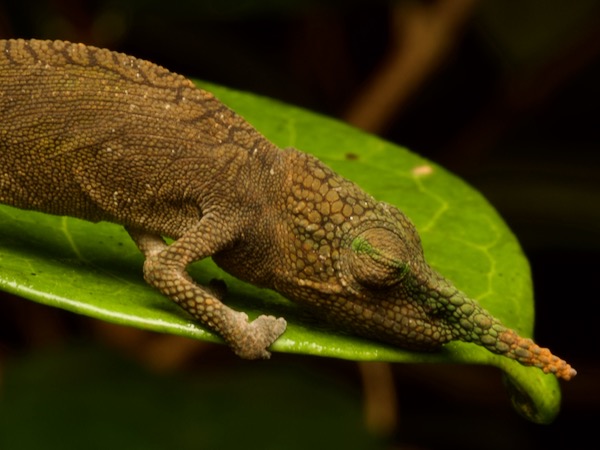
Lance-nosed Chameleon,
Calumma gallus, adult males
But the adult males make this species a worthwhile special target. Those snouts are ridonculous! Nobody will confuse these with any other species.
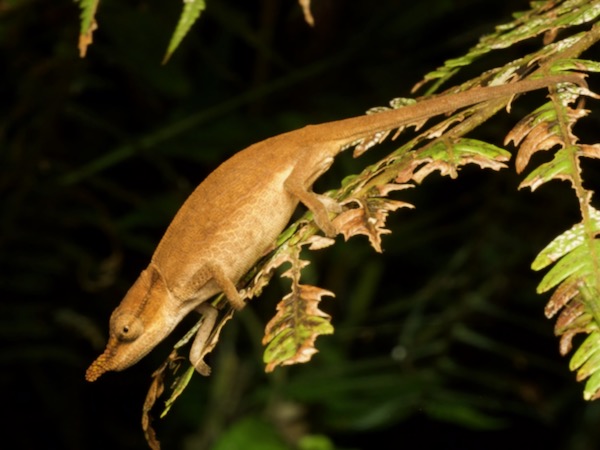
Two-toned Soft-nosed Chameleon,
Calumma roaloko, adult female
Calumma roaloko was formally described
only in 2018, even though it lives in the heavily visited and frequently surveyed Andasibe area. Females like this one aren't especially distinct from
Calumma nasutum and related species, though that silly nasal appendage is a little longer than most, and the darker-on-top, lighter-on-bottom coloration is notable.
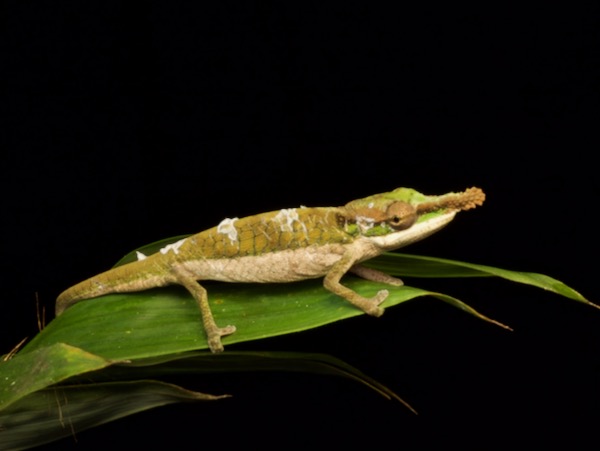
Two-toned Soft-nosed Chameleon,
Calumma roaloko, adult male
Adult males are quite distinctive though. With its extra-prominent nasal appendage, and sharp division between green above and off-white below, and reticulated dorsal pattern, this chameleon couldn't be confused with any previously known species. It is also the current record holder for smallest "true chameleon" from Madagascar (that is, not counting the mostly ground-dwelling Brookesia and Palleon chameleons). Finding this little-known and beautiful chameleon was one of the highlights of our trip.
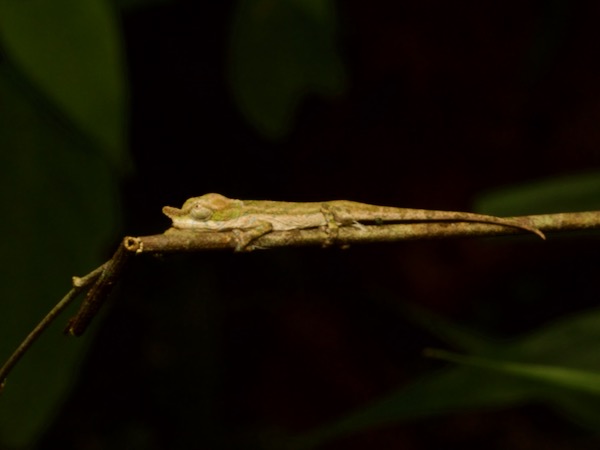
Two-toned Soft-nosed Chameleon,
Calumma roaloko, juvenile male
We also found the cutest little baby male in the same area.
Probably the most common of the larger species that we saw in this area was Calumma brevicorne, which you might remember from Anjozorobe as the species with which Calumma crypticum was formerly confused.
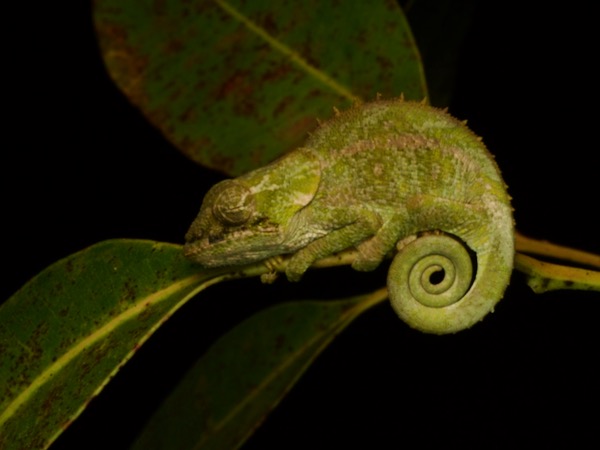
Short-horned Chameleon, Calumma brevicorne, juvenile
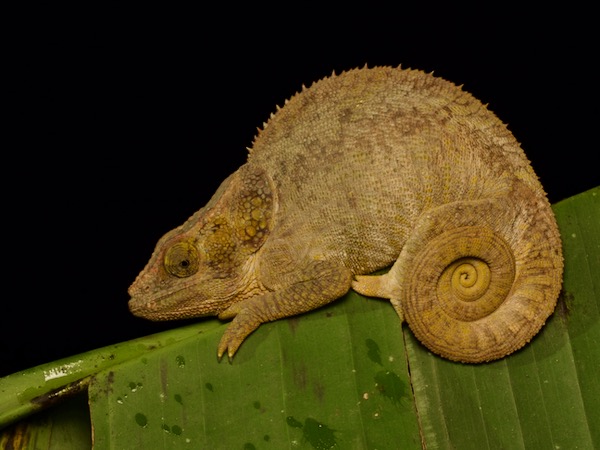
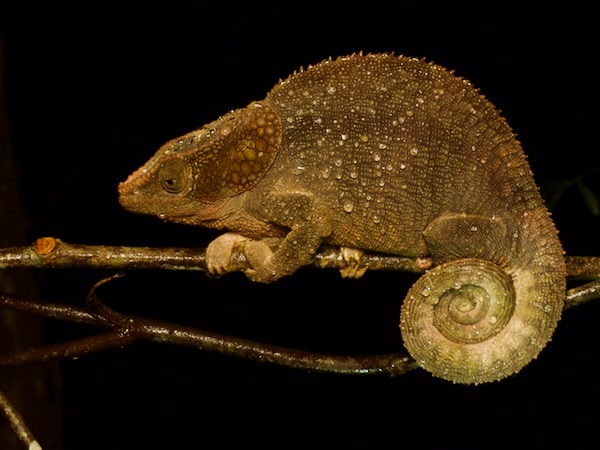
Short-horned Chameleon, Calumma brevicorne, adult females
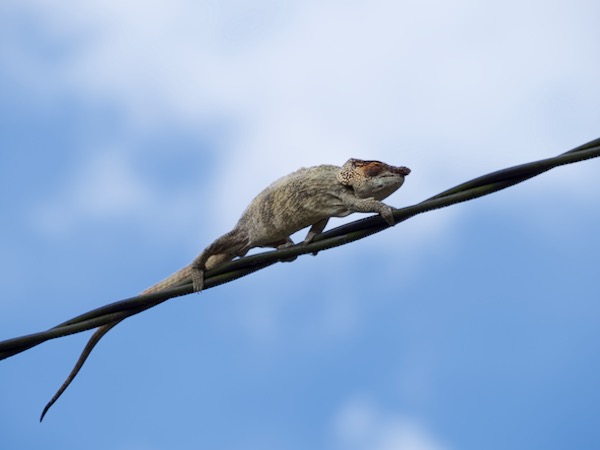
Short-horned Chameleon,
Calumma brevicorne, adult male
In the USA we frequently see squirrels using power lines to get from one place to the next. In Madagascar this system of public transport is utilized by chameleons.
Calumma malthe is a large and dramatic-looking chameleon that I hadn't seen on either of my previous visits. Fortunately the local guide Aristide knew just where to look for them, and we saw several.
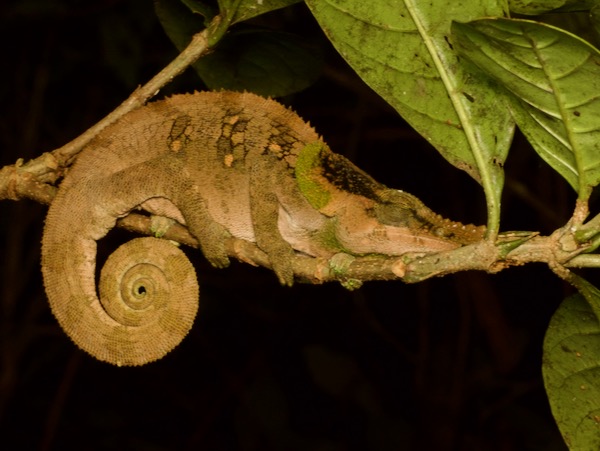
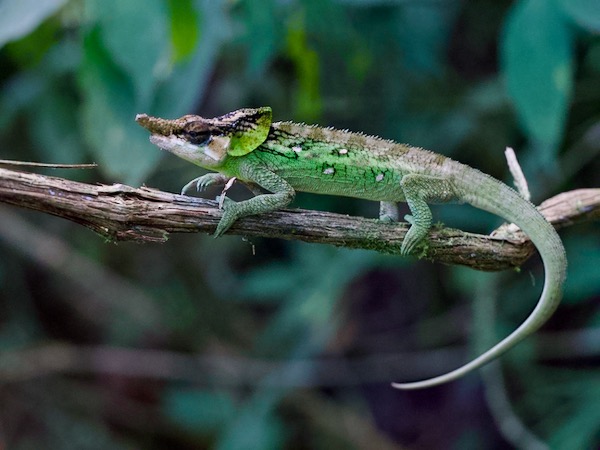
Malthe's Green-eared Chameleon, Calumma malthe, adult males
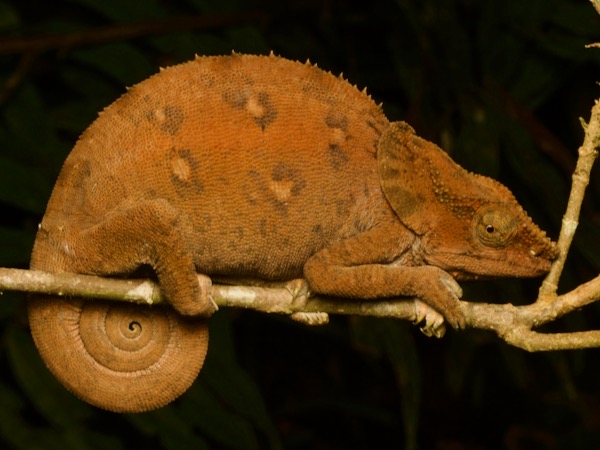
Malthe's Green-eared Chameleon,
Calumma malthe, adult female
No green "ears" on the females, so the common name is sexist, as is often the case.
Everyone loves a giant chameleon, and Calumma parsonii has the honor of being the most giant of all chameleons. Some people argue for Furcifer oustaleti, but I was told in no uncertain terms by both Rainer and José that Calumma parsonii is obviously the winner of the large-chameleon sweepstakes (though perhaps Furcifer oustaleti might achieve a slightly longer length). I am not going to argue with these people. It is futile, I tell you.
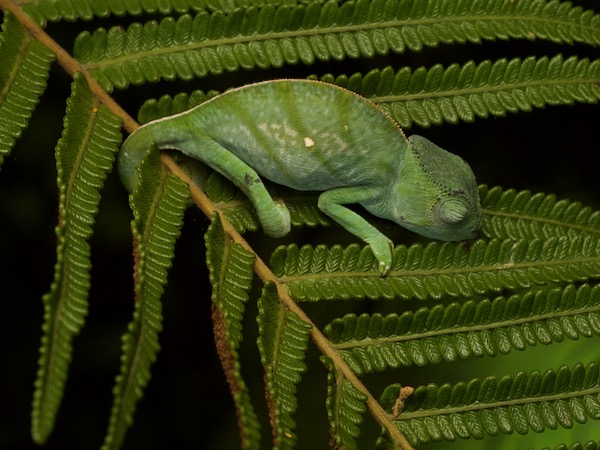
Parson's Chameleon,
Calumma parsonii
This is not however one of those giant ones. This is an adorable little sleeping baby.
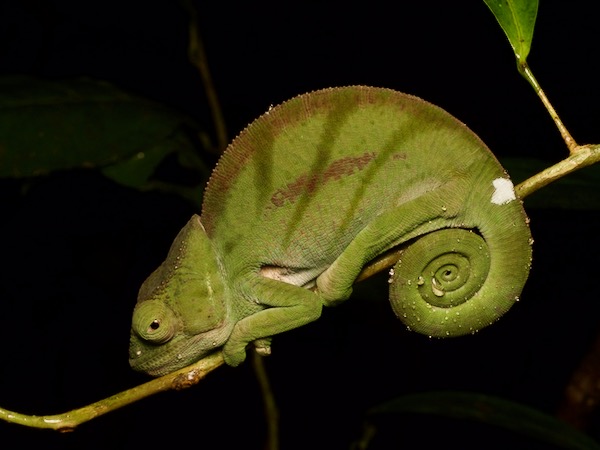
Parson's Chameleon,
Calumma parsonii
This one is also adorable, but a little older. Nowhere near full adult size yet.
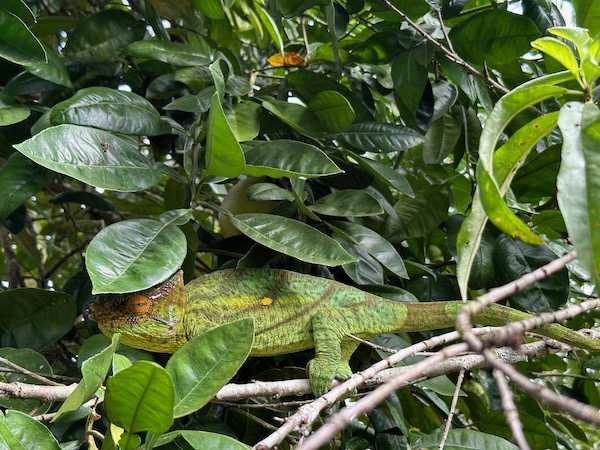
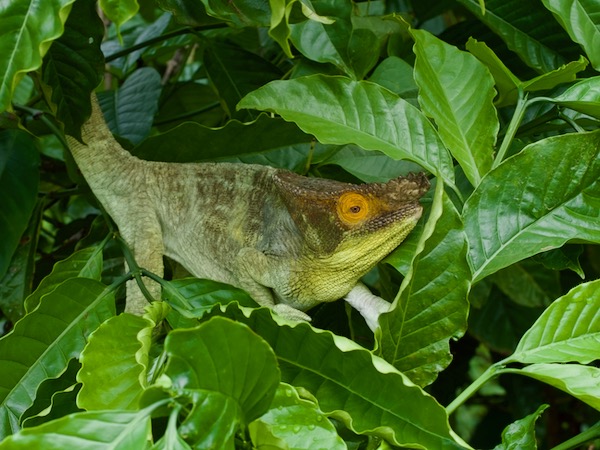
Parson's Chameleon,
Calumma parsonii parsonii
That's more like it! These are a couple of huge adult males. I considered trying to pose for a selfie with one of these behemoths on my head, but decided that the damage to my scalp and ears wouldn't be worth it.
At the same spot where we saw the gigantic Parson's Chameleons, we also saw several Panther Chameleons, a widespread species whose dramatic coloration changes significantly from location to location.
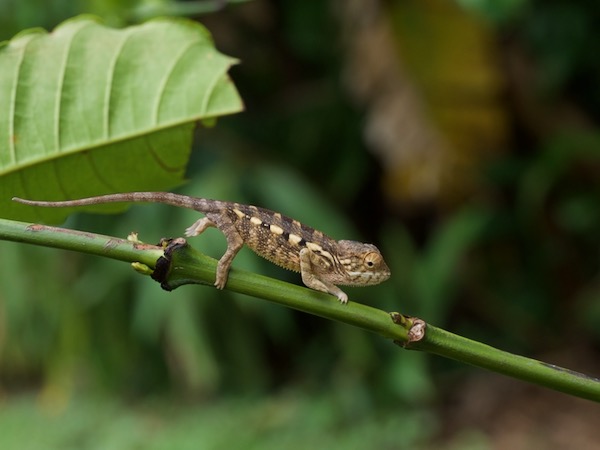
Panther Chameleon,
Furcifer pardalis, juvenile
This little tyke and the other young 'uns we saw sported generic earth tones. Nothing much going on in the color palette here.
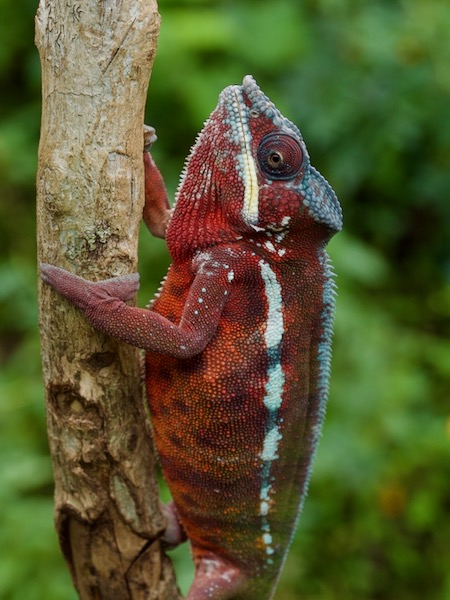
Panther Chameleon,
Furcifer pardalis, adult male
Bright red dominated the high fashion this season for the adult males here.
Furcifer bifidus was a species I hadn't seen before this trip. We found two, both subadults without the pronounced doubled nasal appendage of adults that gives this species its name.
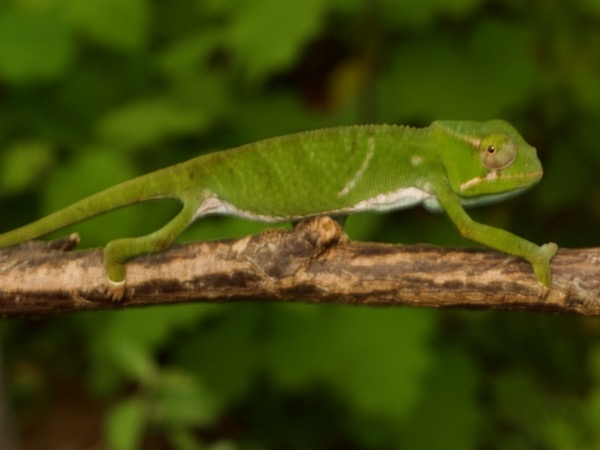
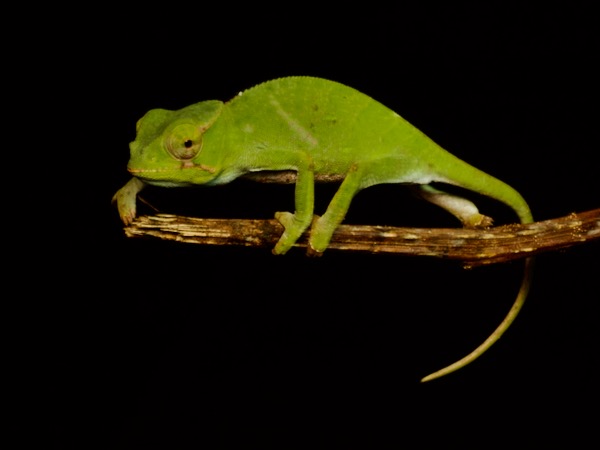
Fork-nosed Chameleon, Furcifer bifidus
Furcifer willsii, the final "true chameleon" species we saw in this area, is mostly found high up in trees. We were lucky to see one very young individual. I guess "lucky" isn't really the right word, because José was determined to find this species and inspected many a small green chameleon, most of which were Calumma gastrotaenia, before he spotted this one. Some luck involved, but also a lot of targeted work.
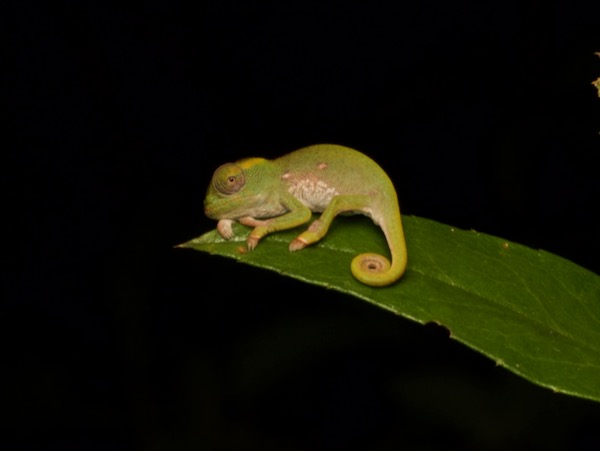
Canopy Chameleon, Furcifer willsii, tiny baby
As I mentioned earlier, I visited the Andasibe area on each of my previous two trips to Madagascar. The total number of Brookesia that I saw on those trips in this area was zero. This time I saw at least 22. This is an example of why it's useful to have world-class herp finders working on your behalf.
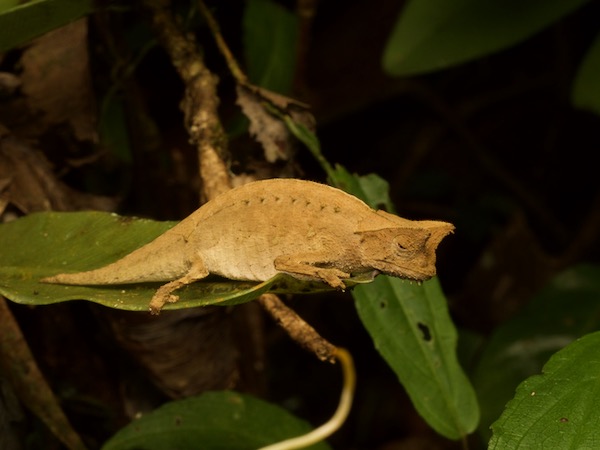
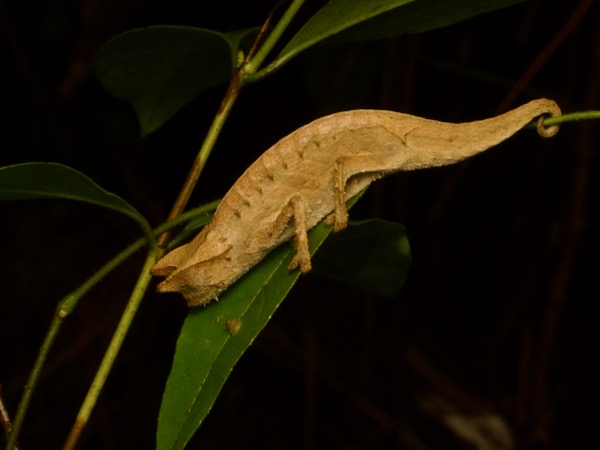
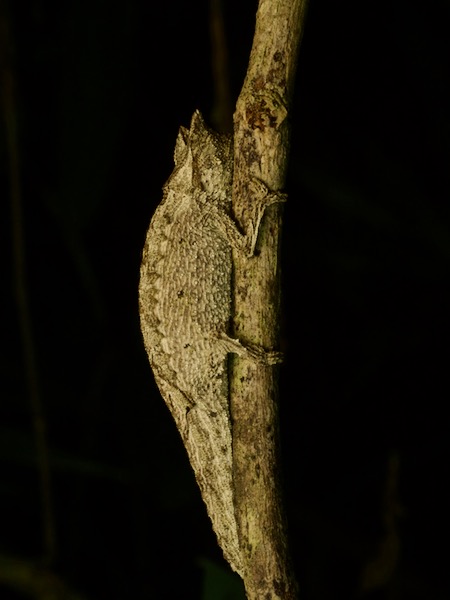
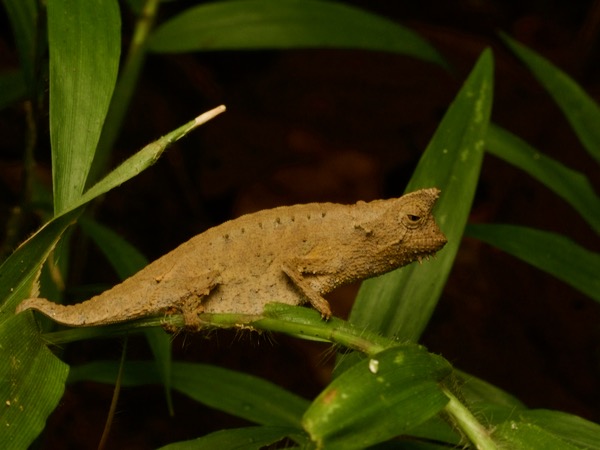
Brown Leaf Chameleon,
Brookesia superciliaris
Brookesia superciliaris was the most abundant, or at least the most easily found, of the leaf chameleons in this area. I photographed 16 of these on this trip near Andasibe.
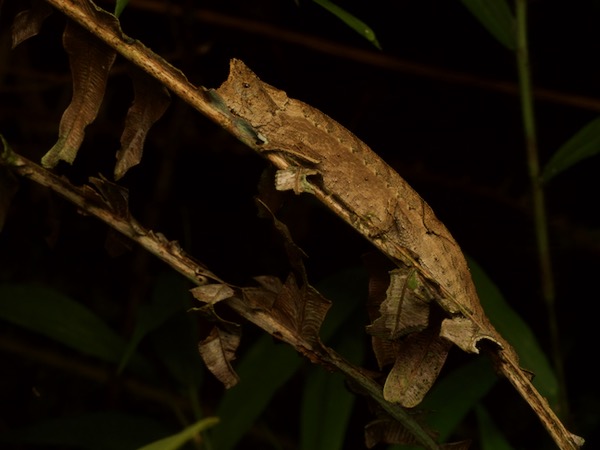
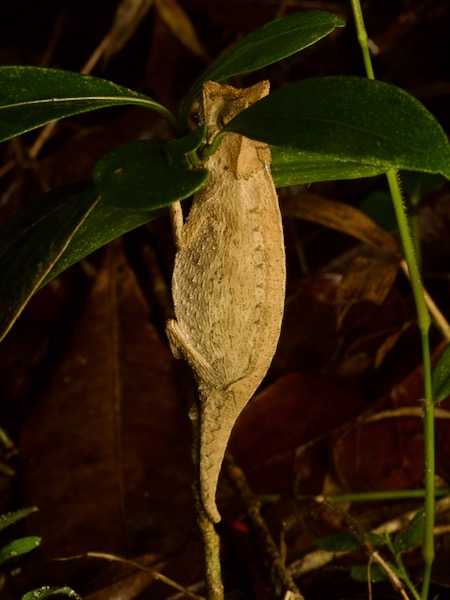
Perinet Leaf Chameleon,
Brookesia therezieni
Brookesia therezieni is very similar to Brookesia superciliaris. The most "obvious" difference is that in this species, the latero-vertebral spines continue onto the tail whereas in B. superciliaris they do not. Got that?
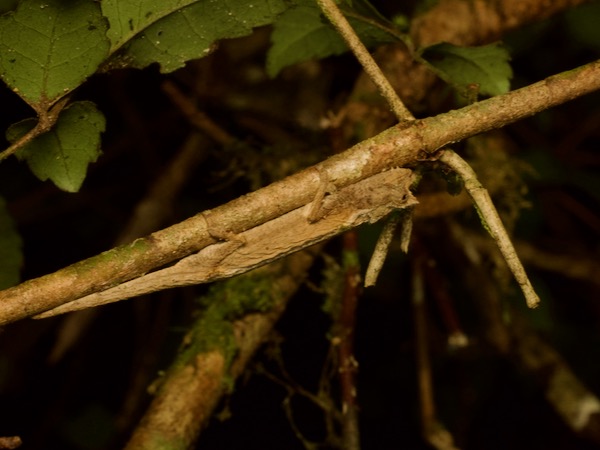
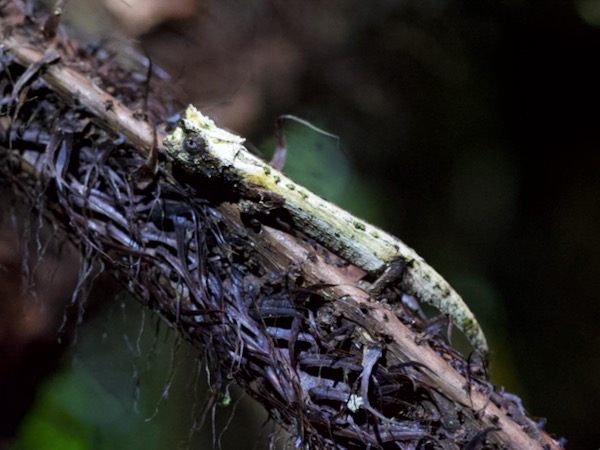
Domergue's Leaf Chameleon,
Brookesia thieli
To be honest, these don't look all that different than Brookesia superciliaris or Brookesia therezieni or a dozen other Brookesia species. but they are somewhat more consistent in width, and lack a pelvic shield.
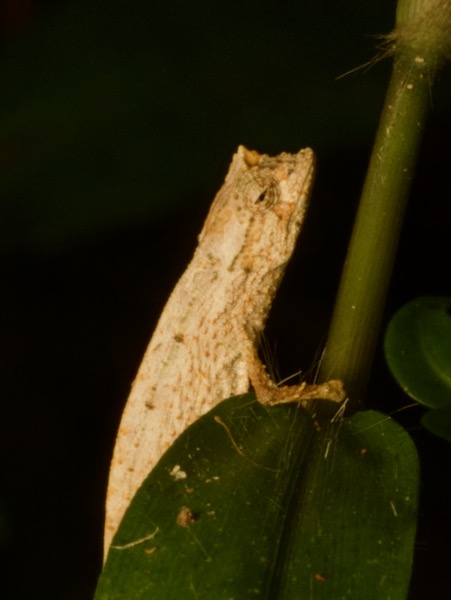
Ramanantsoa's Leaf Chameleon,
Brookesia ramanantsoai
Our final Andasibe-area chameleon is this fine fellow, a relatively little-known species lacking the big pointy bits above the eyes and most of the lateral-vertebral spines. Still, about the same size, and about the same shape, and about the same color as the other nearby Brookesia. I think this species is about 17% more droll than the others.
I only photographed a couple of skinks near Andasibe, both of which were found and captured by Frank, if I'm remembering correctly. A third, similar, skink was caught by Aaron at a time when only he, Mark, and I were around. Our pitiful attempts to get it to pose for a photo ended poorly for us, but well for the nearly-instantly-escaping skink.
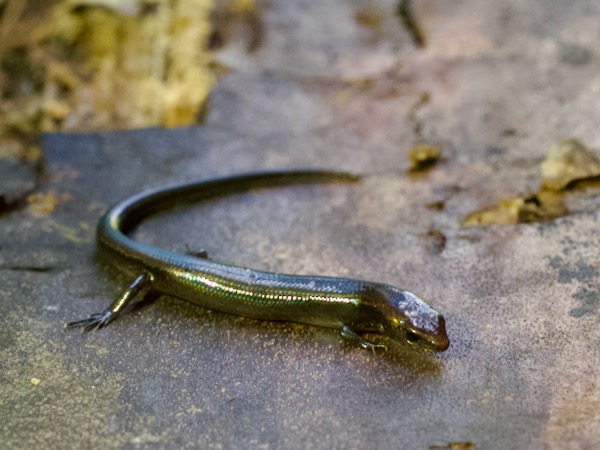
Dwarf Skink,
Madascincus nanus
Several very small and nearly featureless skinks can be found in this area. I think this one is Madascincus nanus based on its particularly tiny size and pronounced iridescence.
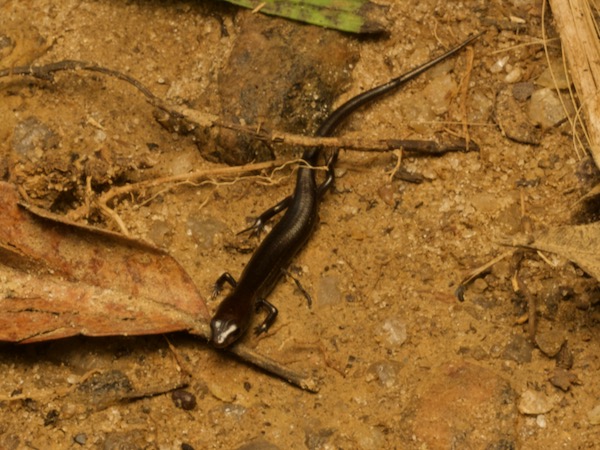
Common Madagascar Skink,
Madascincus melanopleura
This one was a little bigger and less shiny, leading me towards identifying it as this "common" species.
Gecko diversity was impressive around Andasibe, especially compared to the measly three species we had seen at Anjozorobe.
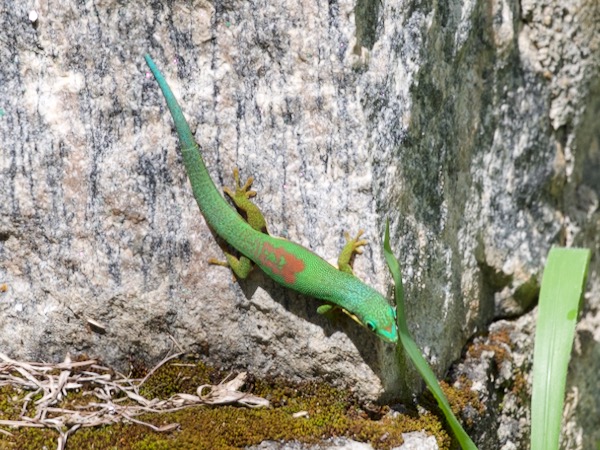
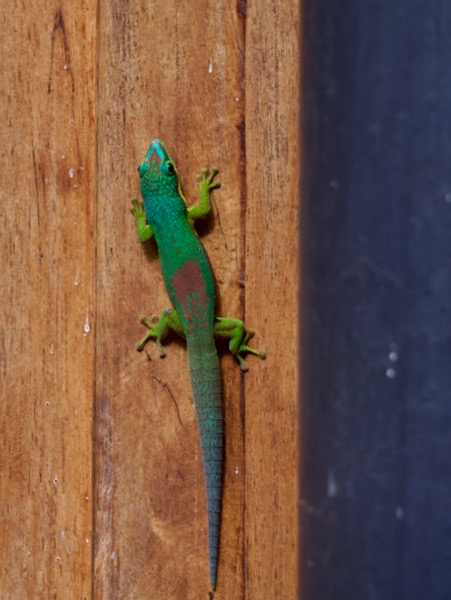
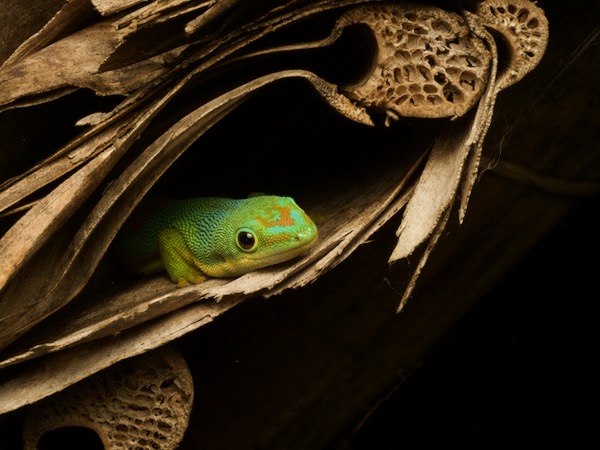
Lined Day Gecko,
Phelsuma lineata
These were the most obvious geckos in the area. We had seen a few at the Anjozorobe lodge, and we saw many more in various spots around Andasibe, mostly on buildings and fences and just occasionally cutely sleeping in roof thatching. In my experience they've been the most common day geckos in eastern Madagascar, but that doesn't make them any less amazing and beautiful.
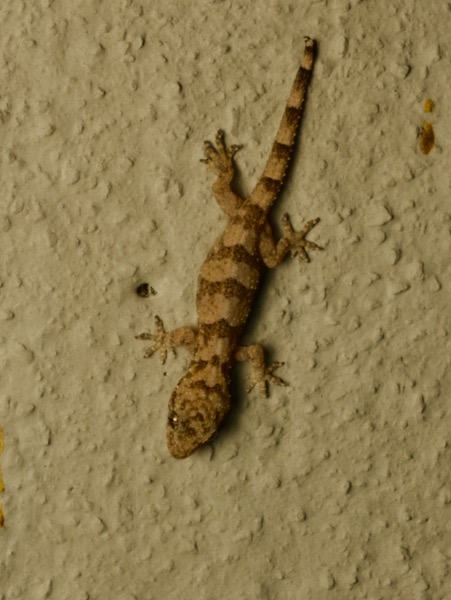
Farquhar Half-toed Gecko,
Hemidactylus mercatorius, juvenile
This is Madagascar's very own "House Gecko", genetically distinct enough from the cosmopolitan Hemidactylus mabouia to warrant species status.
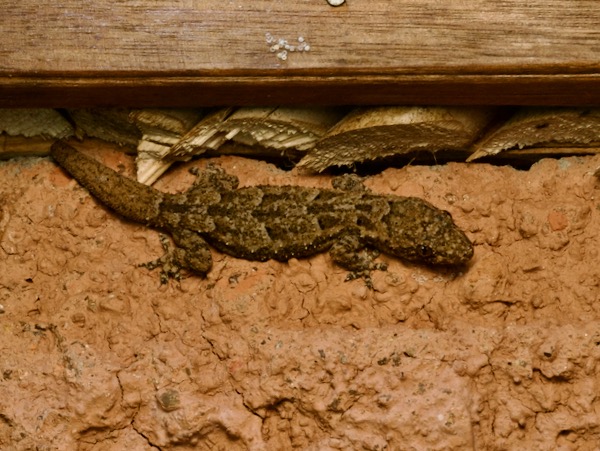
Farquhar Half-toed Gecko,
Hemidactylus mercatorius, adult
Like
Hemidactylus mabouia,
Hemidactylus frenatus, and a bunch of other
Hemidactylus species worldwide,
Hemidactylus mercatorius is seen much more often on buildings than out in the forest.
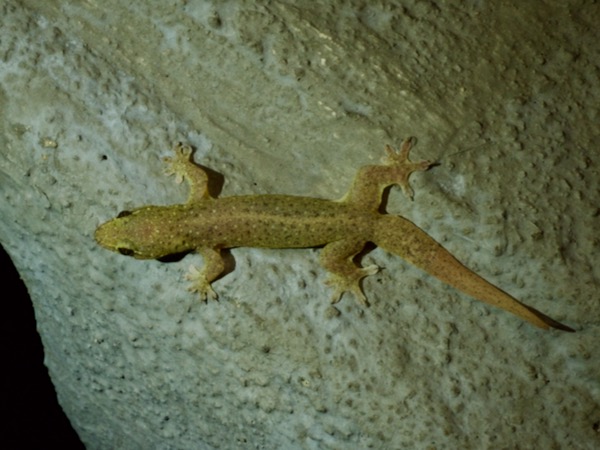
Common Four-clawed Gecko,
Gehyra mutilata, adult
Gehyra mutilata is one of the very few lizard species found in Madagascar that is not endemic to Madagascar. It was probably accidentally introduced by humans at some point. Rainer suspects it came along for a ride with the Malayo-Polynesian people that settled Madagascar around 1500 years ago.
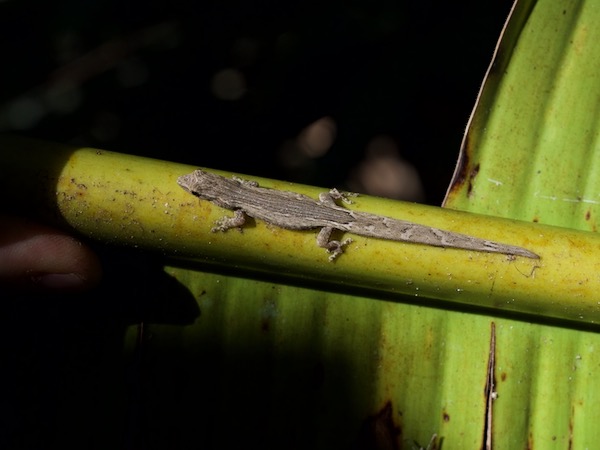
Tiny Dwarf Gecko,
Lygodactylus bivittis
Lygodactylus geckos are often difficult to identify. There are many species, with more and more being described every few years, and morphological differences between species tend to be very subtle at best. However, this one species is distinctive enough that it was formerly placed in a separate genus, Microscalabotes, before being relegated to Lygodactylus to join all the other little brown/gray day-active geckos. This species has a particularly smooth appearance due to very small scales and a lack of the occasional big pointy scales that adorn many other species.
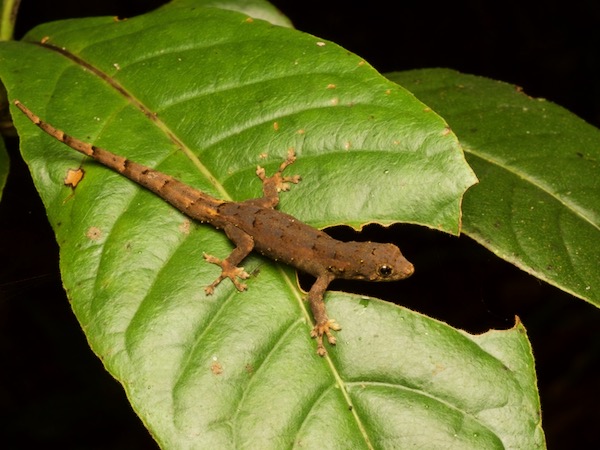
Guibe's Dwarf Gecko,
Lygodactylus guibei
The big pointy scales (technical parlance: "tubercles") are obvious on this one. So obvious, in fact, that their obviousness helps distinguish them from our next Lygodactylus friend.
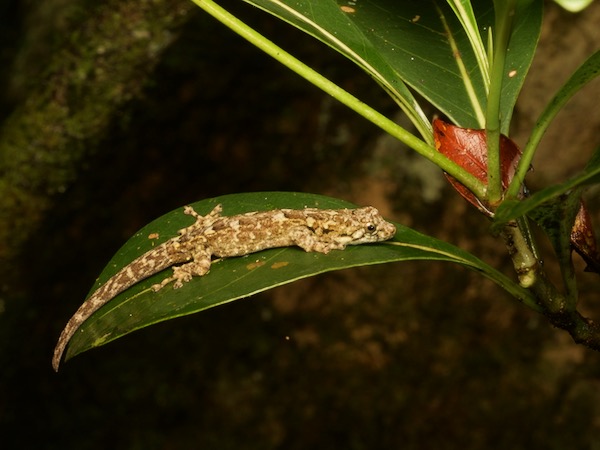
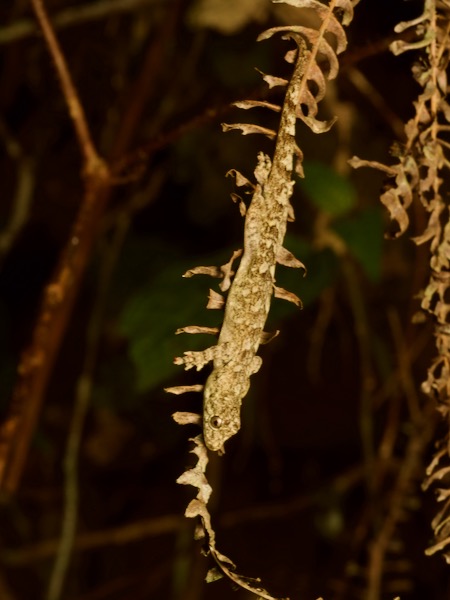
Gunther's Dwarf Gecko,
Lygodactylus miops
These tend to have a pattern dominated by light blotches, as seen in these two individuals. They do have tubercles on their sides, like Lygodactylus guibei, but these tubercles aren't as prominent in this species.
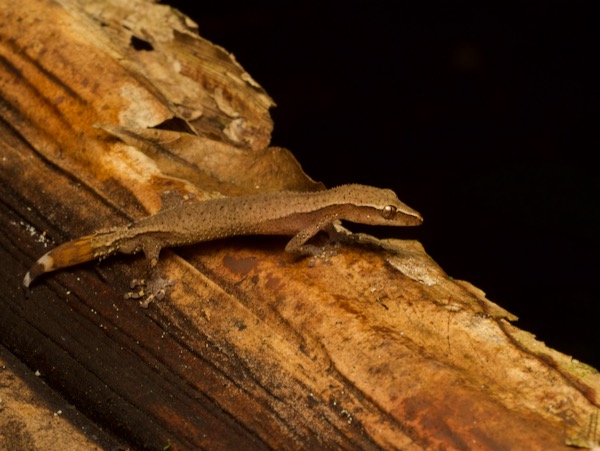
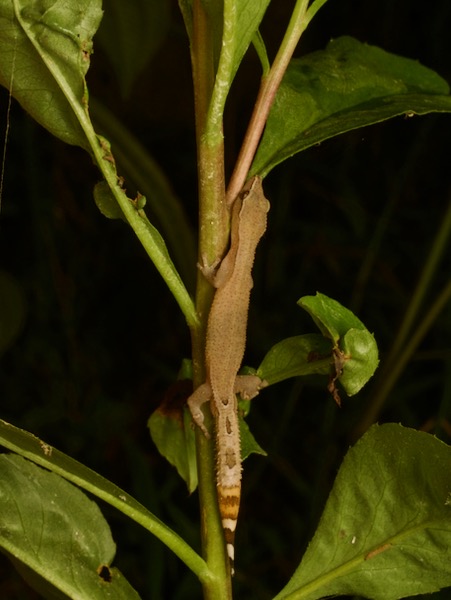
Greater Clawless Gecko,
Ebenavia robusta
I really wanted to see one of these distinctive little geckos, having missed them on my first two trips. I needn't have worried, being in the presence of the master herp-finders from Tropical Herping. José wrangled the first little fella out of dried palm fronds within ten minutes of starting to look for them. We ended up seeing ten Ebenavia individuals on this trip.
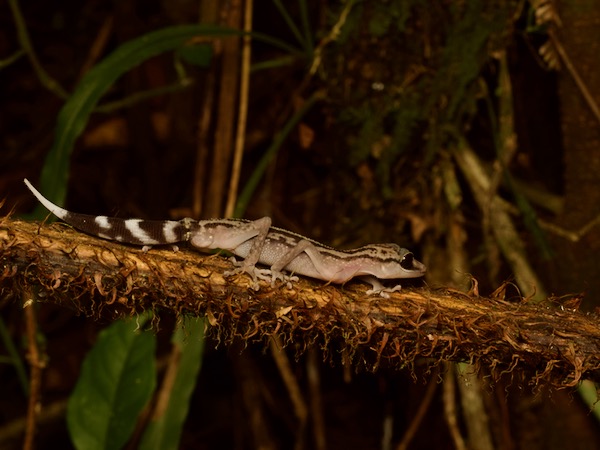
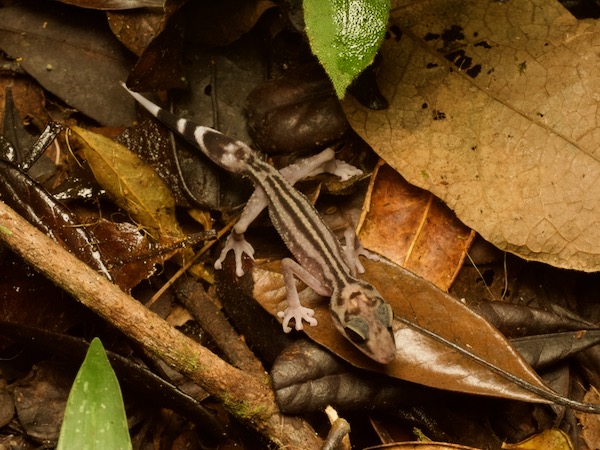
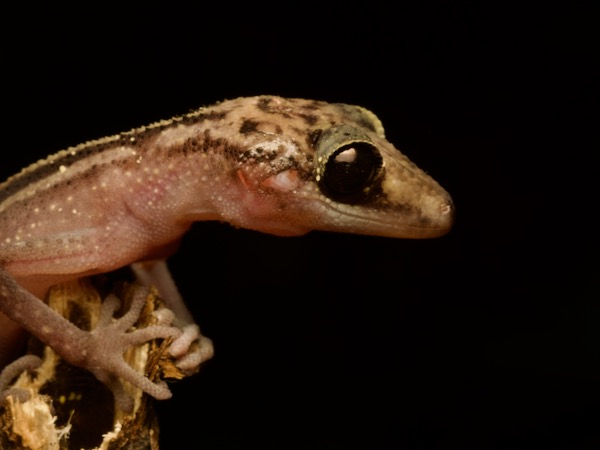
Graceful Madagascar Ground Gecko,
Paroedura gracilis
Most
Paroedura are big chonky geckos prowling on the ground or on boulders. This slender, semi-arboreal, rainforest species is an exception to the rule. I had seen one of these on the Masoala Peninsula the last time I was in Madagascar. The ones there have an "irregular blackish pattern" whereas the ones near Andasibe have "longitudinal blackish lines", according to
Glaw & Vences. There's a large gap between these two populations, so it wouldn't surprise me if they are eventually determined to be separate species. Or, as Glaw & Vences put it, "The taxonomic relevance of the geographic variation needs further study". We ended up seeing six of these in the greater Andasibe area.
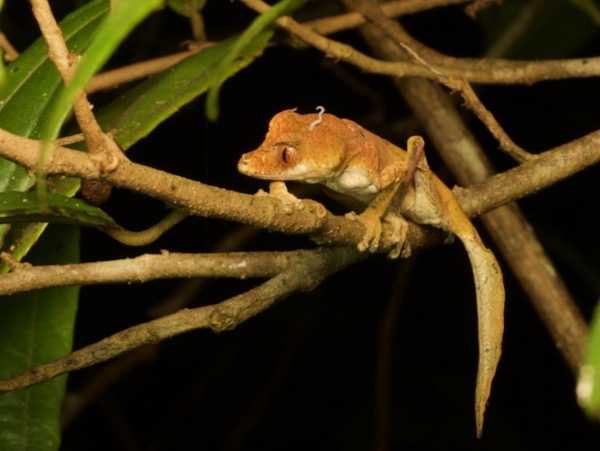
Satanic Leaf-tailed Gecko,
Uroplatus phantasticus, adult female
As you remember, we saw a few of these most excellent geckos in our first stop in Anjozorobe. But one can never see enough Uroplatus phantasticus, or even say the name enough times. Phantasticus. Phantasticus. Phantasticus!
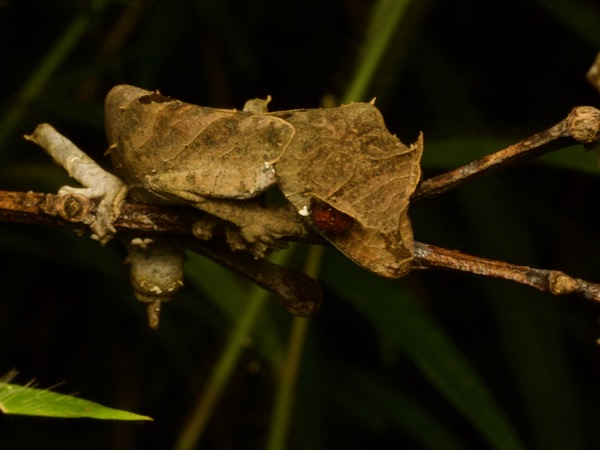
Satanic Leaf-tailed Gecko,
Uroplatus phantasticus, adult male
This poor fellow has lost his imitation-leaf tail, but is still amazing.
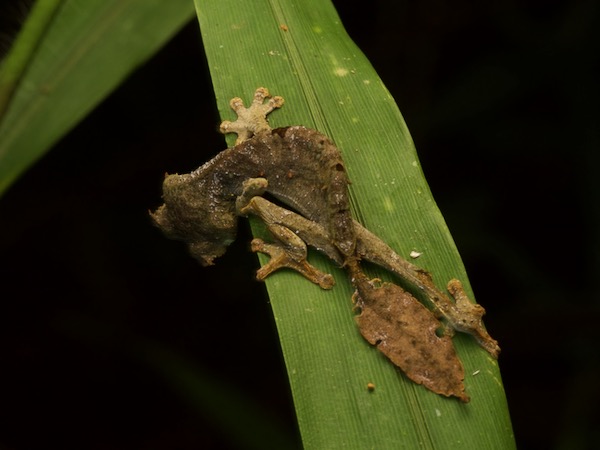
Satanic Leaf-tailed Gecko,
Uroplatus phantasticus, tiny baby male
I was quite proud to notice this inch-and-a-half-long geckoling intently staring into the void from its small frond perch after the local guide and at least one of the Tropical Herping folks had passed it by. Note that even at this very young age, the males already have fake damage to their leaf-like tails. I don't know why males have more of a damaged look than the females. Somebody should study these lizards for their whole life to figure this out, and then tell me.
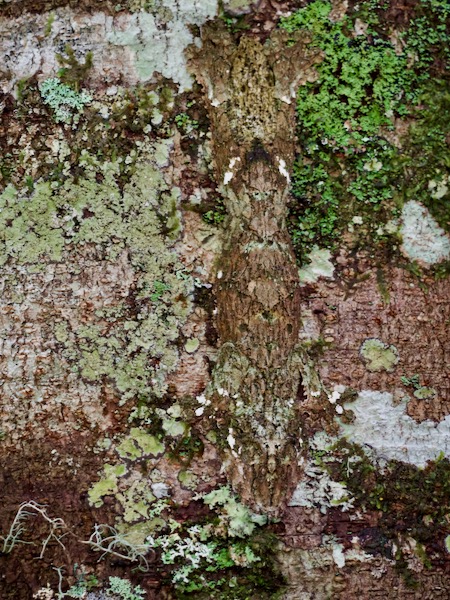
Mossy Leaf-tailed Gecko,
Uroplatus sikorae
You might have been coming to the conclusion that every Uroplatus we came across was of the Satanic style, but that would have been presumptuous of you. We also saw at least four Mossy Leaf-tailed Geckos, starting off when our local guide spotted this one in the standard daytime sleeping position (the gecko's position, not the local guide's). As you might have guessed, these geckos are not easy to notice by day.
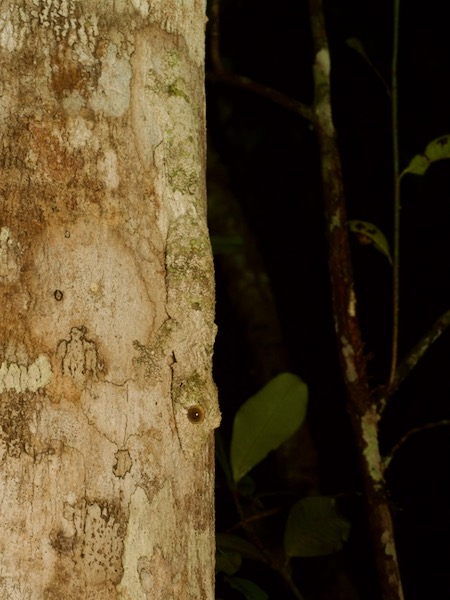
Mossy Leaf-tailed Gecko,
Uroplatus sikorae
This one would have been similarly well hidden but for its big gecko eyes.
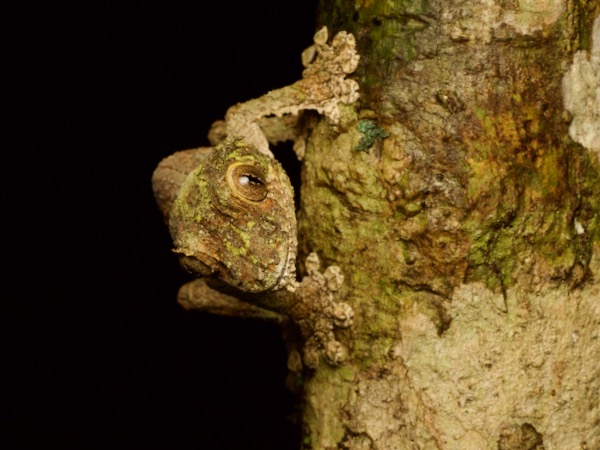
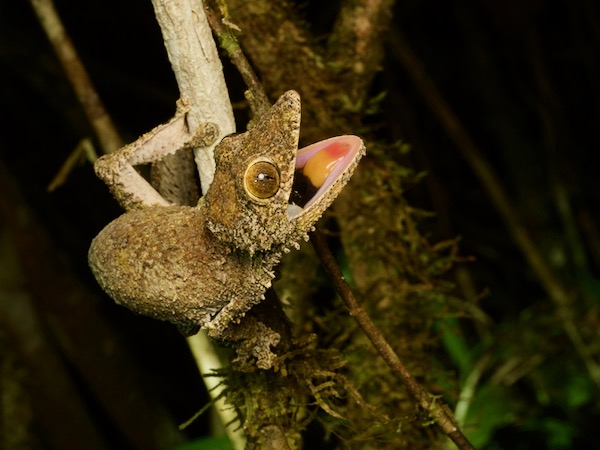
Mossy Leaf-tailed Gecko,
Uroplatus sikorae
When they wake up at night and start prowling for food, they lose their incredible camouflage advantage and become much easier to pick out with a flashlight.
Next: Akanin'ny Nofy



























































































































































